How Star Trek Transporters Actually Work & Why They Are So Scary
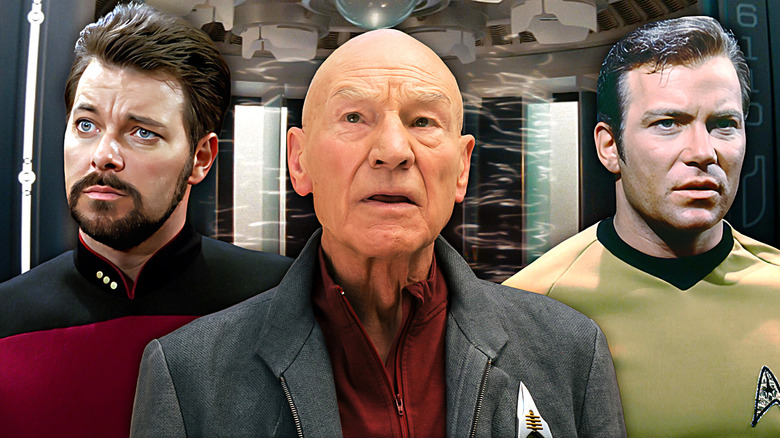
Is there a more handy way to travel than a "Star Trek" transporter? Just step onto the platform with some sidekicks and a couple of convenient redshirts, tell Scotty (James Doohan) or a series-appropriate equivalent to beam you up, and whoosh — you're at the intended destination.
That's how the various "Star Trek" shows present it, anyway. The truth behind transporter tech is far scarier. The device works by turning the person's mass into energy, quite literally beaming said energy to the intended destination, and then converting it back to mass. In other words, it disintegrates the people using it and then rebuilds them in a faraway location. This seems wildly unnerving when you really think about it, and some fans consider transporters to be outright killing-and-cloning devices, making them one of the most questionable things in the "Star Trek" franchise that fans simply ignore .
The prospect of James T. Kirk (William Shatner), Jean-Luc Picard (Patrick Stewart), and others potentially dying and getting replaced with a clone every time they visit an alien planet is a fairly chilling theory, at least if you ask the fans. "Do you really teleport a person from point A to point B, or do you destroy (i.e. kill) a person, and reassemble his molecules in another location into an exact copy of that person, who thinks he's that person? Think about that next time you watch an episode of Star Trek," u/OnlySane1 wrote on Reddit. "The problem is, you'll nether know, because the teleported person does not know if it is just a copy," u/FrozenHaystack shared. However, others, like u/catwhowalksbyhimself and u/IMrMacheteI, have noted that the transporter doesn't kill its user. In fact, some versions of the technology even allow the person to talk or move during the process.

Transporters can malfunction in many creepy ways
While the transporters' matter-conversion process might not routinely kill the transportee, the technology is still fairly unnerving. In fact, several characters find these machines extremely creepy. The in-universe term "transporter phobia" is used to describe people who are scared of transporter machines, and notable characters like Doctors Leonard McCoy (DeForest Kelley) and Katherine Pulaski (Diana Muldaur) have been very wary of using them.
They have good reason to be concerned, too. No matter how secure they are, transporters are still methods of transportation, which means there's going to be an occasional mishap ... and when this sort of technology causes problems, said problems can be extremely serious. The long list of transporter accidents various "Star Trek" characters may encounter includes arriving in the wrong place, time, or even universe. The machine could also de-age the transportees, malfunction in a way that leaves foreign objects embedded in their bodies, or, in an example of a time "Star Trek" went too far , even fatally mangle the poor users. Transporters have also been known to split people into two individuals and merge two different people into one. Early models can even induce a condition known as transporter psychosis – a vast array of untreatable physical and mental issues caused by the damage that transporting causes over time.
Yes, every mode of transport has its dangers. Still, your car is unlikely to leave you randomly stranded in an evil Mirror Universe, which is what happens in the "Star Trek: The Original Series" Season 2 episode "Mirror, Mirror." Even without the laundry list of other potential things that can go wrong with transporters, that alone is more than enough to make the technology a reliable source of legitimately horrifying "Star Trek" stories .
How Star Trek's Transporter Effect Actually Worked
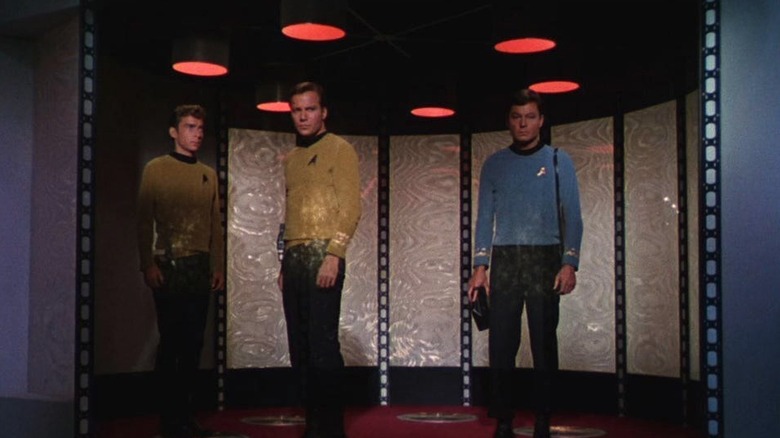
We may receive a commission on purchases made from links.
One of the first memories I have of adult television is watching the cast of the original "Star Trek" beaming down to a planet in the transporter. I don't know which episode it was, but I do remember asking my dad how they did that, and could we go to Disneyland that way. In the days of CGI characters and the ability to film entire movies and TV shows in front of a green screen, it's hard to remember what even a small effect like the "Star Trek" transporter conjured up in our brains. (I still think of it while driving through LA traffic.)
What I didn't know as a kid, and frankly, up until now was how the show created the effect. According to an article on Inverse , The Anderson Company (run in the 1960s by Darrel Anderson and Howard A. Anderson) created it in a very simple way, with "aluminum powder and old-school compositing."
"Here's how it worked: First the person or persons being transported were filmed standing in position. Then they stepped out of frame while the camera captured an empty set. What was then needed was a "mask" of the figures being beamed — essentially an outline of them. A further element required was the glittering or beam effect (this is where the aluminum powder came in). It was photographed separately by dropping the powder from above and lighting it with an intensive light against a black background."
Beaming Ourselves Up
It might seem primitive these days, but someone had to come up with it. Maybe you've even used something like this in your own home movies. A number of years ago (via Vice ), PBS Digital Studio's Joey Shanks showed fans how to create this effect by themselves for their own films. I highly recommend watching the video. It's really cool! It also explains how the effects changed over the years. For instance, they took out the freeze frame effect once the feature films were being made, and they added light beam effects to add drama later on.
Shanks told Vice:
"From my research it started with them using aluminum silver shavings, and just dropping it in front of the camera, backlighting it with a really sharp spotlight and shooting it at 120 frames-per-second and then compositing it into the scene. Then I learned that they started messing around with Alka Seltzer, with glitter, a lot of different forms of liquids and particles in tanks. Just to show the audience this technique it's super simple — even getting a lava lamp that has little glitter particles, you can pretty much create the exact same look they did originally."
Could We Ever Have a Real Transporter?
The effect is super cool, but we can't do that yet, obviously. Will we ever be able to? "Star Trek" has certainly influenced technology with things like flip phones and touch screens. StarTrek.com had an article in 2014 about a discovery that might bring us closer to a real life transporter — in theory. In an experiment at Delft University in the Netherlands, scientists were able to transport a few matter particles three meters. It's not exactly sending a red shirt down to a planet as cannon fodder, but it's pretty cool. The article goes into detail about how it all works (and I'm no scientist, fascinated as I am by it all), but in basic terms, you have to know all the tiny details about something is built and calculate how to move it over a distance, from the atoms out. The atoms have to be rebuilt in exactly the same way somewhere else. Here is a little info from the article to help give you an idea of what we're talking about:
"'If you believe we are nothing more than a collection of atoms strung together in a particular way, then in principle it should be possible to teleport ourselves from on place to another,' says Professor Ronald Hanson, who led the experiment at Delft. Such a day remains far in the future for sure, but Hanson's statement does suggest one further snag that could complicate travel by Transporter — are we just a collection of atoms?"
I spoke to Rod Roddenberry, son of "Star Trek" creator Gene Roddenberry, President of Roddenberry Entertainment and executive producer of "Star Trek: Discovery" and "Star Trek: Picard" about his thoughts on the transporter technology. He said:
"I don't fully recall my first memory of the Transporter technology on screen, but I remember thinking that it was certainly amazing. Transporters represented our control of the atom, similar to the replicators, which allowed us to rearrange atoms in any order thereby creating anything whether it be sustenance, books for education, or rare minerals and metals. This technology would change our perceptions of value and we would no longer see value in material items. Having this ability to create literally anything would over time realign our thinking to find value in more immaterial concepts such as thoughts and ideas. My hope is we will see a future where we recognize and revere what is truly most unique in our world which are the thoughts and ideas of our fellow human beings."
'A Murdering Clone-Maker'
I also spoke to planetary physicist Dr. Kevin Grazier, science consultant on a number of television series and feature films, and co-author of the " Hollyweird Science " series of popular science books who explained:
Even if you could store the titanic amounts of energy needed to transport a person, perform the necessary data management and storage, and overcome quantum effects like the Heisenberg Uncertainty Principle, I still think that if it was possible to place a carbon atom here, a calcium atom there — all in precise relative positions — that the all those atoms would bond in exactly the same way as they were in the original source material. So, I think that if you stepped on one transporter pad, what would appear on the other pad is a huge puddle of organic sludge with the identical bulk chemical composition as the now-deceased Captain Busch. [Author's note: That's me and yikes!] The transporter is great narrative tool to keep writers from having to spend time landing their starship or dispatching a shuttle to a planet week to week, but I'm with Doctor McCoy in believing that the transporter is, at best, a murdering clone-maker.
By the way, Dr. Grazier does expand on the energy and data storage calculations in Chapter 7 of the first "Hollyweird Science" book.
So, would you want to have one of these? Do you think we'll ever get there? Let us know @slashfilm !
Star Trek's Use of Transporters, Explained

Your changes have been saved
Email Is sent
Please verify your email address.
You’ve reached your account maximum for followed topics.
Quick Links
Why star trek has transporters in the first place, how transporters work in star trek stories, is there any real scientific basis for star trek's transporters, is a star trek character the same person after being transported.
There are many iconic things about Star Trek , from the communicators that inspired flip cell phones to the unmistakable silhouette of the USS Enterprise . However, one of the most iconic elements of Gene Roddenberry's universe are the transporters that "beam" characters from one place to another. This technology is one of the earliest and most high-concept ideas in those early shows. Yet, it was born -- like so much in television production -- out of a need to save money. So, how does the fantastical transporter system work? If someone who wasn't a fan of Star Trek was asked to quote a line of dialogue from the show, they most likely would say, "Beam me up, Scotty."
The chief engineer of the original USS Enterprise was also the one often tasked with overseeing this complicated and sometimes dangerous process. Yet, the phrase never appears in Star Trek: The Original Series . In fact, the closest fans ever got to hearing it was in Star Trek IV: The Voyage Home . While saying goodbye to Gillian, their 20th Century marine biologist ally, Kirk says, "Scotty, beam me up." Throughout every future iteration of the franchise, the transporter is a crucial part of the technological armaments used in the stories. While no single science-fiction concept is wholly original, the transporter is one element that's rarely copied by other storytelling universes. Doctor Who uses them, but it's often only the aliens or antagonists who have access to them, and for good reason. While it saved money for production, conceptually it complicates the series' drama.
Best Star Trek Episodes of 2023
Star Trek had a big year in 2023, and that means there were far more excellent episodes than could fit on anyone's list. These were some of the best.
Looking back at Star Trek: The Original Series , modern-day viewers can be forgiven for saying it looks "cheap." Yet, during its day, the show was one of the most expensive on television, which is why The Original Series was canceled despite strong fan support. In fact, while still in development, Gene Roddenberry almost blew the budget simply researching starships. From that experience Roddenberry said, "I would blow the whole budget…just in landing the [ship] on a planet," in The Fifty-Year Mission: The First 25 Years by Edward Gross and Mark A. Altman. "[T]he transporter idea was conceived, so we could get our people down to the planet fast…and get our story going by page two."
The technology also allowed the characters to only bring the props they could carry like phasers, communicators and tricorders. Anything else they needed could simply be transported to them. Len Wein, a writer on the early Star Trek comics , chided earlier writers for showing the characters with backpacks, because anything they needed was a simple beam-down away. Still, the transporter posed a problem for the production crew. It was one of many visual effects techniques that had to be invented for the series. Sure, the use of composite shots -- which allow figures to appear or disappear -- existed as long as motion picture cameras. But in Star Trek , everything had to be bigger.
In The Fifty-Year Mission , visual effects legend Howard A. Anderson talked about how they achieved the effect. They "used aluminum dust falling through a beam of high-intensity light" photographed separately. Using matte shots, they would shoot the characters, followed by a cut-out of the character with the glitter effect, and then make the effect disappear leaving an empty transporter pad. It was one of the show's simpler shots, but that, along with the sound, became a beloved hallmark of the series. Despite modern advancements, the transporter effect still has elements of the original.
Star Trek's Renaissance Is So Strong, It Has Its Own Awards Show
After decades of being ignored by the Emmys and Golden Globes, the Virtual Trek Con has the LLAPys, an awards show just for the Star Trek franchise.
In most cases, the transporters still work the way they were intended to, namely by getting characters into the action quickly. However, they are also a source of drama. In Captain's Logs: The Unauthorized Complete Trek Voyages , also by Gross and Altman, Roddenberry lamented about a cut scene from the (second) pilot where Dr. McCoy gives voice to his concern about using it. The line told fans "one of these days we may see a story about a transporter malfunction." When this eventually happened in The Original Series , for "regular viewers, it comes out of the blue," he said. A transporter malfunction is also how the show introduced Star Trek's infamous "Mirror Universe."
Of course, if the characters could simply be whisked out of dangerous situations with a transporter, it hurts the drama. In The Fifty-Year Mission: The Next 25 Years , second-wave writer and producer Hans Beimler said they "had to break down the transporter…so that [the characters] could be in trouble." This is why there are so many "ionic storms" or stories set in deep caves. The character of Dr. Pulaski on Star Trek: The Next Generation shared Dr. McCoy's contempt for transporters, too. Yet, it wasn't always a hindrance to the storytelling.
In The Next Generation Season 6, a transporter malfunction created a double of Riker who spent years on a planet waiting for rescue. In Star Trek: Voyager , another malfunction -- in concert with an alien flower -- bonded two characters together into a new being in the episode "Tuvix." As recently as 2023, the transporters were used in Star Trek: Picard as a key element of the Borg's plan to stealthily invade Starfleet by assimilating the officers under the age of 25. This technology is about much more today than getting characters to a planet quickly and cheaply.
Star Trek's 'Other Gene' Is an Unsung Original Series Pioneer
Creator Gene Roddenberry was the visionary behind Star Trek: The Original series, but much of what fans love came from the franchise's other Gene.
It's surprising how scientifically accurate a show like Star Trek can be, even without its science consultants. In an early The Original Series episode, Captain Kirk makes reference to what sounds like a black hole, a year before the term appeared in scientific literature, according to science consultant and astrophysicist Erin MacDonald on NPR's Science Friday . Regretfully, she said the transporter is not one of those things. Beyond the massive task of disassembling and reassembling seven billion-billion-billion particles, there are the laws of physics to contend with, namely the Heisenberg Uncertainty Principle.
The scientific concept states there is an incalculable measure of uncertainty in measuring and locating a particle at any given time. Star Trek sometimes takes liberties with real physics. MacDonald noted the depiction of gravity waves in Season 4 of Star Trek: Discovery was depicted inaccurately because it was more visually appealing. It is a television series, after all. Still, Star Trek tries to account for these things. In certain episodes when transporter "technobabble" is required, there's an element called a "Heisenberg Compensator." This accounts for the uncertainty, but asked how it works, all MacDonald can say is "very well, thank you."
There are more recent elements that are equally scientifically preposterous, especially the "pattern buffer." This is a memory storage device that holds a transporter "pattern." In The Next Generation , Scotty is found alive decades after his disappearance inside one. Strange New Worlds used the concept, too. Dr. M'Benga used it to store wounded Starfleet officers in the Klingon war and, later, his own daughter who had a degenerative disease. It makes for great fiction, but it's not real science. In fact, there is a massive debate about whether the transporter kills each person who goes through it.
This Underrated Star Trek Series Has the Franchise's Best Pilot
The first episode of any series starts the story without being fully formed, yet the pilot episode of Star Trek: Enterprise is the franchise's best.
In Star Trek: Enterprise Season 4 , the inventor of the transporter, Dr. Emory Erickson visits the ship for an experiment that's a secret plan to save his son, lost in a transporter accident. During the episode, he dismisses out-of-hand the idea that the transporter "kills" the people who use it. However, it's not so easy to dismiss. The transporter breaks down the physical structure of a person to the smallest particle and then rebuilds them in a different location. There is an argument to be made that they are not the "same" person who went into the machine. Instead, they are a new being who possesses the same matter and memories, or in Will and Thomas Riker's cases, two people with the same matter and memories.
With this philosophical question, there is no clear answer. Dr. Erickson is convinced the idea is nonsense, but Star Trek: Picard proved it's not so beyond the pale. The Starfleet officers had their DNA rewritten with biological Borg elements they didn't have before. Dr. Crusher notes the "bio-filters" should've caught it. These filters are supposed to be able to remove contaminants and pathogens an away team might pick up on an alien planet.
While the transporter is reassembling a person's particles, it can and does change them when required. This is a fan-debate for which there is no clear answer, nor should there be. For Star Trek's purposes, however, the people who are transported aren't killed in the process. The one exception is the people in Star Trek: The Motion Picture whose molecules were scrambled by beaming aboard the refitted USS Enterprise . Despite Roddeberry's desire for his universe to hew closely to real-world science, Star Trek 's transporters are its most magical technology.
The Star Trek universe encompasses multiple series, each offering a unique lens through which to experience the wonders and perils of space travel. Join Captain Kirk and his crew on the Original Series' voyages of discovery, encounter the utopian vision of the Federation in The Next Generation, or delve into the darker corners of galactic politics in Deep Space Nine. No matter your preference, there's a Star Trek adventure waiting to ignite your imagination.

Transporter

Constitution II -class transporter room
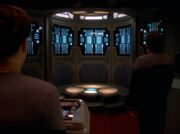
Defiant -class transporter room
The transporter was a type of teleportation machine, or simply teleporter . It was a subspace device capable of almost instantaneously transporting an object from one location to another , by using matter-energy conversion to transform matter into energy , then beam it to or from a chamber , where it was reconverted back or materialize into its original pattern. ( TOS : " The Squire of Gothos ", " The Savage Curtain "; PRO : " First Con-tact ")
Alternate names for the transporter included matter stream converter , energy-matter scrambler , or transporting device . ( TOS : " The Savage Curtain ", " The Empath "; ENT : " Broken Bow ", " Vanishing Point "; TNG : " Ship In A Bottle "; VOY : " Ex Post Facto "; SNW : " The Broken Circle ") The Organians referred to Klingon transporters as material transmission units . ( TOS : " Errand of Mercy ") The Ferengi referred to theirs as a matter-energy device . ( TNG : " The Last Outpost ") Spock determined that the device used by the Vians that beamed himself, Leonard McCoy , and James T. Kirk to an underground location on the planet Minara II , was what he described as a matter-energy scrambler . ( TOS : " The Empath ")
Someone who was transported by a transporter beam was known as a transportee . ( TOS : " Day of the Dove ")
On the Sci-Fi Diner podcast, Catherine Hicks recalled " “[I] said to Bill and Leonard before a take where we beam up, I said, ‘Where should I be playing here? I mean, what does it feel like to beam up?’ And they said, ‘It tingles.’” " [1]
- 1.1 20th century
- 1.2 21st century
- 1.3 22nd century
- 1.4 23rd century
- 1.5 24th century
- 1.6 25th century
- 2.1 Safety features, protocols, and components
- 2.3 Diagnostic and maintenance tools
- 2.4 System components
- 3.1 Personnel
- 3.3 Portable
- 3.4 Emergency
- 3.6 Micro-transporters
- 3.7 Non-"beam" transporters
- 3.8.1 See also
- 4.1 Accidents
- 4.3 Shields
- 4.4 Warp speed
- 4.5 Faster-than-warp speeds
- 4.6 Radiation and substances
- 4.7 Devices
- 4.8 Transporting the injured
- 5.1 Automatic return
- 5.2 Disabling active weapons
- 5.3 Falsifying disintegration by a phaser
- 5.4 Connecting two transporters
- 5.5 Intraship beaming
- 5.6 "Site-to-site" transport
- 5.7 Transporter trace
- 5.8 Deflecting the transporter beam
- 5.9 Single-person transport
- 5.10 Faking a transporter accident
- 5.11 Emergency mass beaming
- 5.12 Narrow confinement beam
- 5.13 Skeletal lock
- 5.14 Offensive use
- 5.15 Medical transports
- 5.16 Rematerialization without clothes
- 5.17 Other operations
- 6.1.1 Origins
- 6.1.2 Sets and props
- 6.1.3 Special effects
- 6.1.4 Legacy
- 6.2 Apocrypha
- 6.3 External links
History [ ]
20th century [ ].
The Vulcans had teleporter technology since at least as early as the late 20th century . This might have been an early version of the standard transporters that were later used in the Federation . ( PIC : " Mercy ")
21st century [ ]
Circa 2069 , the planet Terra 10 was colonized by a group of Humans from Earth . They were considered a lost colony as they had lost communication contact with United Earth until the 23rd century , when they were re-discovered by the crew of the USS Enterprise .
During this period, the Terratins either retained prior knowledge of transporter technologies or developed their own. It might have predated development of the technology on Earth. ( TAS : " The Terratin Incident ")
22nd century [ ]
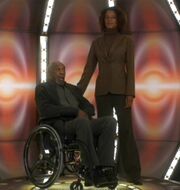
Emory Erickson, the inventor of the transporter, with daughter, Danica Erickson
Although transporters had been used by many civilizations throughout history , the first transporter to be made on Earth was invented sometime prior to 2121 , originated by Emory Erickson , who was revered as the " Father of the Transporter". The first operable transporter was developed around 2124 .
Erickson later recalled his experience as the first person to go through a transporter, which he was terrified to attempt. According to Erickson, " that original transporter took a full minute and a half to cycle through. Felt like a year . You could actually feel yourself being taken apart and put back together. When I materialized, first thing I did was lose my lunch . Second thing I did was get stone drunk . " Years later, Erickson lamented that " during the initial tests for the transporter, some brave men and women were lost, " adding, " not a day goes by that I don't think about them. " Though his vision was a success, he could never recapture his past glory, as his follow up efforts with sub-quantum teleportation were never realized, an effort that ultimately led to the loss of his son, Quinn . ( ENT : " Daedalus ")
In an illusion created during Hoshi Sato 's eight seconds in the pattern buffer , her mind created a fictional story of a man named Cyrus Ramsey . In this apparent ghost story , as told through an illusion of Trip Tucker , an event occurred in Madison , Wisconsin in May 2146 , where " Ramsey was a test subject for the first long-range transport. Just one hundred meters . Something went wrong with the pattern buffer. He never rematerialized. " Malcolm Reed , who couldn't believe that Sato had never heard the story before, since one could not " go on a survival overnight without hearing a story about someone seeing Ramsey's molecules rematerializing on a foggy night . " ( ENT : " Vanishing Point ")
Long before the transporter was established as having been invented by Emory Erickson, Gene Roddenberry imagined the transporter as a Human invention, rather than a Vulcan one. ( Star Trek: Communicator issue 142 , p. 72)
Early Starfleet efforts in the application of transporter technology were similar to 24th century transporters used by the Ligonians , but Ligonian transporters used the Heglenian shift method to convert matter and energy. ( TNG : " Code of Honor ")
Enterprise NX-01 was one of the first Starfleet starships to be equipped with a transporter authorized for transporting biological objects. Initially, however, it was utilized only sparingly, due to a general distrust of the technology held by Enterprise crew members. (The captain himself refused to put his dog through the system.) Its use became much more common during Enterprise 's search of the Delphic Expanse . ( ENT : " Broken Bow ", " Strange New World ", " The Andorian Incident ", " Fortunate Son ", " Hatchery "; " Countdown ", et al. )
As an indication of the abilities of this type of early transporter, Matthew Ryan stated, in the first draft script of "Fortunate Son", that a dozen of them would enable the crew of the ECS Fortunate to unload that freighter in an hour.
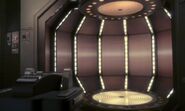
These early transporters were not very reliable, and, even after Enterprise 's mission, most were authorized for non-biological transports only. Even when transporter use became commonplace, most Humans and other races at a similar stage of technological development preferred traditional methods of travel. ( ENT : " Strange New World ", " The Andorian Incident ", " Daedalus ")
As Starfleet continued its exploration of space, dependence on transporters grew significantly. Transporters could simplify away missions considerably by eliminating the need for a shuttlecraft . In case of emergencies (medical or otherwise), the time saved could mean the difference between life or death. ( ENT : " Strange New World ")
Before 2164 , on at least Freedom -class starships , the transporters were only meant for cargo and not organic matter. However, they could be modified to transport organic matter with some risk. ( Star Trek Beyond )
23rd century [ ]
With the advent of safer transporters, biological transport became increasingly common, which led to the appearance of the first transporter-related diseases. The best-known disease was transporter psychosis , which was diagnosed in 2209 on Delinia II . Following the perfection of the multiplex pattern buffers , such cases were virtually eliminated. ( TNG : " Realm Of Fear ")

A Lateral Vector Transporter in use in 2249
By 2249 , further advancements were made in perfecting the technology, this time by reducing power consumption. Older units, such as lateral vector transporters had been discarded on Vulcan due to the massive amount of power they required. Starfleet had also phased them out, but some older ships, such as the Walker -class USS Shenzhou , still had them installed. ( DIS : " Battle at the Binary Stars ")
24th century [ ]
Transporters became the most reliable form of short-range transport by the 24th century . ( TNG : " Realm Of Fear ")
Most space-faring civilizations of the Alpha and Beta Quadrants employed transporter technology for short-range transport of personnel and equipment, however the technology was still rather unknown in the far reaches of the Delta Quadrant . To these species, the many advantages to utilizing transporters and replicators made the technology a point of contention, especially between the Kazon and the crew USS Voyager . ( VOY : " Caretaker ", " Maneuvers ", et al.)
Traveling by transporter was essentially instantaneous and an individual's sense of time while transporting was effectively non-existent. Benjamin Sisko and Harry Kim , while training at Starfleet Academy in San Francisco , frequently transported to New Orleans and South Carolina , respectively, to see their parents. ( DS9 : " Explorers "; VOY : " Non Sequitur ")
Innovations in transporter technology around this time included safer site-to-site transport , which allowed for transport between two locations without first returning to a transporter room . ( TNG : " The Game ", et al.)
25th century [ ]
In 2401, Starfleet's transporter systems were tampered with by rogue Changelings allied with the Borg . They infiltrated Starfleet and implanted Jean-Luc Picard 's Borg-altered DNA into the transporter system as 'common biology' that would only manifest in those whose brains had yet to finish development (in Humans under 25). The result was that every Starfleet officer within those criteria had been given Picard's 'receiver' gene, which would render them susceptible to Jack Crusher 's transmitter gene. The Borg Queen assimilated Jack and exploited this to assimilate all affected Starfleet personnel on Frontier Day . ( PIC : " Võx "). Following the defeat of the Borg, Doctor Beverly Crusher devised a method of using the transporters to remove the Borg-altered DNA and to uncover disguised Changelings. ( PIC : " The Last Generation ")
By the 29th century , Starfleet had developed temporal transporter technology that allowed travel through time in a very similar manner to standard transporters of earlier centuries. ( VOY : " Relativity ")
Operations [ ]
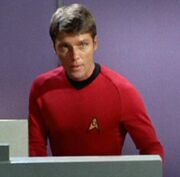
Transporter chief Wyatt
In general, a transporter chief was responsible for the operational readiness, maintenance and repair of a ship or station's transporter systems.
A typical transport sequence, generally initiated by the request to "energize", began from the transporter console with transporter pre-sequencing that, once complete, transporter coordinates were established on the object or destination by the targeting scanners , which thereafter a transporter lock was made. ( VOY : " Jetrel ", " Initiations ", " Twisted ")
Simultaneously, the object was broken down into a stream of subatomic particles, also called the matter stream . ( TNG : " Datalore ") The transporter signal was then transferred to the pattern buffer, then again transferring to the emitter array . ( VOY : " Eye of the Needle ", " Twisted ") The matter stream was then transmitted to its destination across a subspace domain . ( TNG : " The Best of Both Worlds, Part II ") When used, a transporter left residual ionization in the air . ( TNG : " The High Ground ")
Of this whole process, one did not feel a thing. ( TNG : " The Dauphin ")

Transporter effect of the alternate reality 's USS Enterprise
In 2258 of the alternate reality , the transporter operation process included the use of the annular confinement beam, followed by electromagnetic focusing and the use of a gravitational compensator . The transporter operator then applied a temporal differential and engaged a particle lock . ( Star Trek )
The information about the alternate reality transporter process comes from on-screen graphics of the transporter control panel, shown in several scenes of the film Star Trek .
23rd century Klingon transporter systems shared the same basic technology as Federation transporter systems. Even though the transporter systems of an Intrepid -class were much more sophisticated than those of a D7 class , the targeting scanners worked on the same principles. With exception of the more advanced systems having had the ability to expand transporter buffer capacity, they really were not all that different. ( VOY : " Prophecy ")
As of 2368 , Cardassian transporting systems still operated with active feed pattern buffers. ( TNG : " The Wounded ")
Also during this time frame, Romulan transporters were known to operate on a similar subspace frequency to those used aboard Federation starships, and with only a few minor adjustments, they could be made to simulate the transporter carrier waves used by their Federation counterparts. ( TNG : " Data's Day ")
From its earliest incarnations until the 2270s , transporters generally immobilized the subject being beamed during dematerialization and rematerialization. Advances in transporter technology after that point allowed a person being transported to move or converse, during the process, in a limited fashion. ( Star Trek: The Motion Picture , Star Trek II: The Wrath of Khan )
By the 24th century, emergency transporter armbands , transponders and combadges could be programmed to remotely activate a transporter. Normally, remote transporter activation was limited to emergencies or when the crew of a vessel was not on board. ( TNG : " The Best of Both Worlds ", " Realm Of Fear "; DS9 : " The Jem'Hadar ")
Safety features, protocols, and components [ ]
As with other Starfleet technology, the transporter had its own set of safety features, protocols, and procedures. In an emergency, many of these safety systems could be modified or circumvented.
Early versions of the transporter in the 22nd century appeared to have no protection against external incursions into an active transport. "Foreign matter," such as blowing debris, could get caught up in the transport and become embedded or integrated into the subject. ( ENT : " Strange New World ") Energy weapons fire would also affect the subject, unless it was sufficiently far into the transport that the fire passed through it harmlessly. ( ENT : " Broken Bow ", " Countdown ") By the late 23rd century , however, transporters shielded the subject from these external incursions. ( Star Trek VI: The Undiscovered Country ; TNG : " A Matter of Perspective ") They could even neutralize particle weapon fire initiated during transport. ( TNG : " The Most Toys ")
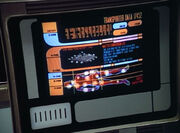
Seven of Nine's transporter data
Biofilters were uniformly used on all Federation transporters by the 24th century. These filters functioned to decontaminate transported objects and prevent harmful substances, pathogens, and even certain forms of radiation (including theta radiation ), from contaminating the rest of the ship or station. This process replaced earlier systems that required the subject to be fully rematerialized on the transport platform before applying an energy-based process to topically decontaminate the transportee. ( VOY : " Macrocosm ", " Night "; TOS : " The Naked Time ")
Though the biofilters performed a general contaminant removal with each transport, they were far from perfect; previously unknown infections or viruses occasionally failed to register, requiring the filters to be recalibrated to recognize the new threat. As such, biofilters were incapable of filtering out certain types of substances and pathogens, most notably psychic energy. ( TNG : " Lonely Among Us ", " Power Play ")
Biofilters were also unable to detect and filter certain types of phased reality lifeforms without prior calibration. Biofilters also functioned to detect and disable weapons and explosives ( remat detonators , for example). ( TNG : " Realm Of Fear ", " The Schizoid Man ", " The Most Toys ")
The transporter also saved biological data of the individuals transported. In 2374 , The Doctor was able to give a diagnosis on Seven of Nine 's irrational behavior after studying her last recorded transporter data. ( VOY : " The Raven ")
When knowingly transporting material considered a biohazard , such as a virus , a bio-transport authorization was used to document the material's nature and approve the transport. ( TNG : " The Child ")
Except in cases of extreme emergency, protocols prohibited transporting objects while traveling at warp speed. ( TNG : " The Schizoid Man ") Such transports are possible, however, if the two vessels match warp velocities. ( TNG : " The Best of Both Worlds "; VOY : " Maneuvers ")
During the 22nd century, standard Earth transporter systems had a range of ten thousand kilometers ; however, by the 24th century, the maximum range of standard transporter systems was about forty thousand kilometers, though a special type of transport, called subspace transport , could beam over several light years . ( ENT : " Rajiin "; TNG : " A Matter Of Honor ", " Bloodlines ") Many 24th century starships were equipped with an emergency transporter system, but these only had a range of, at best, ten kilometers. ( VOY : " Future's End ")
Although having a maximum range of about forty thousand kilometers, some conditions adversely affected the effective range. In at least one instance – due to missing components of Voyager 's primary computer systems – the starship Voyager had to be within five hundred kilometers of a planet's surface to use transporters on Kathryn Janeway and a hologram of Leonardo da Vinci . ( VOY : " Concerning Flight ")
For context, five hundred kilometers above the surface of Earth would place the ship inside the ionosphere, but it would be still around one hundred kilometers higher than the orbit maintained by the International Space Station.
The maximum range of a transporter differed by species, depending on what kind of technologies they used to build it. The transporter with the longest known range was that of the Sikarians , with a range of about forty thousand light years; however, this was due to their planet 's large quartz mantle, which amplified their transporter signal. Because of this, Sikarian transporter technology worked only on their homeworld . ( VOY : " Prime Factors ")
The unknown alien world on which Gary Seven was raised possessed transporter technology with a range of at least a thousand light years, according to Spock . Montgomery Scott later noted that Seven's beam was so powerful it fused all recording circuits, and therefore he could not say exactly how far it transported Seven, or even whether it transported him through time. Exactly how they achieved this effect remains unknown, since there has been no subsequent contact with them, and they hide their entire homeworld in some fashion. There were, however, other indications that their technology was considerably advanced beyond that of the 23rd century Federation. ( TOS : " Assignment: Earth ")
The Vedala , one of the oldest space-faring races, also possessed transporter technology capable of beaming people and equipment to and from other planets (presumably in different star systems). ( TAS : " The Jihad ") Dominion transporter technology, enhanced with a homing transponder , was said to have had a range of at least three light years. ( DS9 : " Covenant ")
Diagnostic and maintenance tools [ ]
- Magneton scanner
- Micro-resonator
- Parametric scanner
- Synchronic meter
- Test cylinder
System components [ ]
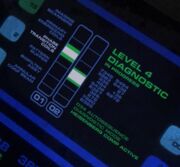
A level 4 diagnostic listing several key components
- Annular confinement beam
- Biofilter assembly
- Emitter array
- Gravitational compensator
- Heisenberg compensator
- Imaging scanner
- Inducer module
- Materializer
- Molecular imaging scanner
- Particle lock
- Pattern buffer
- Phase discriminator
- Phase inducer
- Phase transition coil
- Primary energizing coil
- Rematerialization subroutine
- Rotational compensation
- Site-to-site transport interlock
- Targeting scanner
- Transporter console
Transporter types [ ]
Almost all Starfleet facilities and starships were equipped with at least one transporter device. The number of transporter devices differed; for example, most shuttlecraft had one transporter while Galaxy -class starships had twenty. ( TNG : " 11001001 ")
On ships where cargo bays were present, cargo transporters could often be found, as well.
Production of Mark V transporters was halted in 2356 . By 2371 , Mark VI transporters were considered outdated. Mark VII transporters were able to transport unstable biomatter , as long as the phase transition inhibitor was adjusted. ( DS9 : " Family Business ")
Personnel [ ]
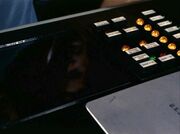
Transporter console, 2254
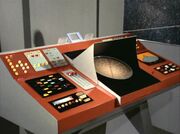
Standard duotronic transporter console (ca. 2260s )

Transporter console in the alternate reality 's 2258
The most commonly used type of transporter was the personnel transporter, designed primarily for personnel.
Personnel transporter rooms usually consisted of a transporter console , a transporter platform with an overhead molecular imaging scanner , primary energizing coils , and phase transition coils .
A pattern buffer with a biofilter was typically located on the deck below the transporter room. The outer hull of a starship incorporated a number of emitter pads for the transporter beam. ( TNG : " Realm Of Fear "; VOY : " Macrocosm ")
Personnel transporters worked on the quantum level to enable secure transport of lifeforms. Biofilters built into the transporter systems prevented dangerous microorganisms from boarding the ship.
Transporter platforms had a variable number of pads, arranged in various layouts (by model and by manufacturing race).
The transporters installed on Earth's NX-class starships featured one large circular pad that took up the entire platform. It was large enough to transport two to three people, provided they stood close together.
By the 23rd century, Federation transporter platforms featured multiple independent pads, typically six in a hexagonal configuration. One- and two-pad platforms were also available.
This became something of a standard layout for Federation transporters well into the next century. As an example, the platforms used on board Galaxy -class starships had the familiar six individual pads, with an over-sized pad (in the center of the platform) that could handle small cargo.
The model of transporter installed on board Defiant -class starships featured a ¾ circular platform and three personnel pads in a triangular formation.
Some 23rd century Klingon platforms featured six hexagonal pads in a straight line. Others, such as those on Birds-of-Prey , featured a small number of platforms in a tight group. ( Star Trek IV: The Voyage Home ; Star Trek VI: The Undiscovered Country )
Cardassian transporter platforms in the 24th century featured three to five triangular pads placed close together, such as those installed on Deep Space 9 .
Armin Shimerman considered the transporters on Deep Space 9 as integral to the station. ( Star Trek: Deep Space Nine Companion , p. 695)
The personnel transporter was a reliable but sometimes fragile piece of equipment. The phase coils , in particular, were vulnerable to feedback patterns and could be severely damaged as result of power surges or low-level phaser fire. ( TNG : " Brothers ")

A cargo transporter aboard a Galaxy -class starship
Cargo transporters were larger-scale versions of personnel transporters and were optimized for the transport of inanimate objects. These transporters were adapted to handle massive quantities of material. ( TNG : " Symbiosis ", " The Hunted ", " Power Play ")
In case of an emergency, cargo transporters could be reset to quantum-level mode, making lifeform transport possible. One reason for such a reconfiguration was to expedite an evacuation of personnel. ( TNG : " 11001001 ")
Cargo transporters were mostly found inside the cargo bay of a starship or space station . On Level 97-C of the Spacedock -type Starbase 74 , there were four cargo transporters. ( TNG : " 11001001 ")
Dedicated cargo transporter platforms used by Starfleet in the 24th century typically featured one large circular or oblong pad. ( Star Trek: The Next Generation )

A transporter aboard the USS Franklin
In the alternate reality , the USS Franklin was only equipped with cargo transporters. After the discovery of the Franklin 's wreckage, Montgomery Scott was able to modify the transporters to beam lifeforms, though he only beamed Spock and Leonard McCoy on board one at a time so as not to risk splicing them together . With aid from Pavel Chekov , Scott was able to further modify the transporters to beam groups of twenty at a time though the transporters needed to recharge after at least two groups of twenty in a row. After Scott's modifications, the transporters were also able to beam two lifeforms and a motorcycle in motion to a destination. ( Star Trek Beyond )
Portable [ ]
Portable transporters were self-contained units capable of direct site-to-site transport . While having the capability to be moved from one place to another, they were known to be rather large and bulky. ( DS9 : " Visionary ")
In 2372 of an alternate timeline , Tom Paris owned an advanced, portable, site-to-site transporter device capable of transporting itself along with its payload. This device was small enough to be carried easily on a person. ( VOY : " Non Sequitur ")
Emergency [ ]
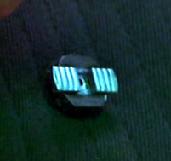
An emergency transport unit
Emergency transporters were a special type that had a low power requirement; in case of a ship-wide power failure, the crew could use these transporters for emergency evacuation. ( Star Trek: The Next Generation Technical Manual ; VOY : " Future's End ")
In older technical manuals and other non- canon background materials, these are sometimes referred to as "evacuation" transporters or "combat" transporters. Typically, they are said to be platforms with a dozen or more pads each. In addition to emergency evacuation, they are used in any high-volume movement of personnel, such as in troop deployment.
By the late 24th century, emergency transport was further improved through Starfleet's development of a single-person, single-use, one-way emergency transport unit . The device was small enough to be hand-held and could transport to specified coordinates with a single touch. Because of its extreme limitations, this device was not widely deployed and was still considered a prototype in 2379 . ( Star Trek Nemesis )
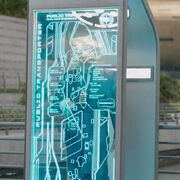
A public transporter in use
Public transporters were standalone transporter stations available for use by the civilian population of Starbase Yorktown . These automated units featured a selection of pre-programmed destination coordinates available to each user, allowing access to many public locations throughout the starbase. ( Star Trek Beyond )
By 2399 , Starfleet Headquarters had public transporters in a gatelike configuration, which visitors could use to be directly beamed to the premises. ( PIC : " Maps and Legends ")
Micro-transporters [ ]
By 2375 , the Federation had developed a micro-transporter – essentially a scaled-down version of a regular transporter – which was capable of transporting small amounts of material within an almost-imperceptible span of time. When attached to a TR-116 rifle , it could be used to transport the bullet to anywhere within the transporter's range, where it would continue at its original velocity until striking a target. ( DS9 : " Field of Fire ")
Non-"beam" transporters [ ]
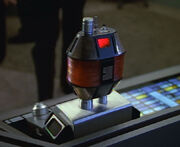
The spatial trajector , an example of a non-beam transporter
Certain species experimented with transporters that differed in technology and theory than those used by most species encountered by the Federation.
The Sikarians were known to use a folded-space transporter , relying on dimensional shifting rather than matter-to-energy conversion. Similarly, the Iconians perfected their own form of transport, known as gateways , which were capable of near-instantaneous transport over vast distances. ( VOY : " Prime Factors "; TNG : " Contagion ")
Other transporter technologies [ ]
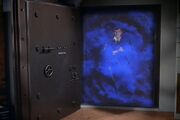
Gary Seven emerges from the transporter chamber's fog

Gary Seven's office, with the transport chamber hidden in the background
Gary Seven possessed an advanced form of transportation technology that he used to transport around the planet Earth and back to his home planet more than a thousand light years from Earth. When in operation, the chamber produced a cloud of a blue fog-like substance that enveloped the chamber. The chamber was controlled by the Beta 5 computer and was the first known transporter to be in use on Earth, especially given the time period of 1968 .
The transporter beam could be intercepted by another transporter unit. This occurred when Gary Seven was in transit to Earth and his beam was accidentally intercepted by the USS Enterprise commanded by James T. Kirk . This would seem to dictate that both transporter technologies work on similar principles. Seven's device appeared to be more powerful than that of the Enterprise , for it was able to re-direct the transporter beam of the Enterprise back to it, and instead of Gary Seven re-materializing in the transporter room of the Enterprise , he re-materialized in his own device.
When not in use, the chamber door, which resembled that of a safe when it was closed, was hidden behind a shelf holding Martini glasses. The shelf and the brown wood finish surrounding it split down the middle and slid into the adjacent walls, allowing the chamber door to open. This action was achieved by moving the right pen on Gary Seven's desk downward. ( TOS : " Assignment: Earth ")
This device was not identified on-screen. According to the final draft of the script, it was stated that " [i]t is obvious this "wall vault" camouflages what is actually some highly advanced type of "Transporter." "
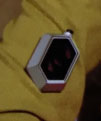
An Aldean transport device
The Aldeans wore a small device attached to the arm that they used to control their transporter through contact with the Custodian . ( TNG : " When The Bough Breaks ")
This device was described in the episode's script as an "arm device" or "arm band".
See also [ ]
- Folded-space transporter
- Lateral vector transporter
- Matter-energy scrambler
- Molecular transporter
- Multidimensional transporter device
- Sub-quantum teleportation
- Temporal transporter
- Translocator
Limitations [ ]
Accidents [ ].
- See : Transporter accident
- See : Transporter suspension
Shields [ ]
In general, transporters could not be used while the deflector shield of a ship was active, or a deflector shield was in place over the destination. However, it was possible to take advantage of EM "windows" that were created by the normal rotation of shield frequencies. During these periods, a hole opened, through which a transporter beam could pass. To use this window, timing needed to be absolute and usually required substantial computer assistance. This technique was theorized and first practiced in 2367 , by USS Enterprise -D transporter chief Miles O'Brien . He happened to know the shields of the USS Phoenix well, including the timing. ( TNG : " The Wounded ")
Magnetic shields could also be used to prevent beaming. Rura Penthe was protected by such a shield to prevent prisoners from escaping. ( Star Trek VI: The Undiscovered Country )
There was a type of shielding that allowed transport, although it had the limitation of not allowing phasers to be fired through it. ( TOS : " A Taste of Armageddon ")
The limitation of transporters versus shields was not universal, however. The Aldeans were able to pass through their own shielding using transporters, though the shielding was impenetrable to other forms of technology and weapons. Similarly, both the Borg and Dominion used transporter technology that was able to penetrate standard Federation shielding. Some adaptations, including rotating shield frequencies, could inhibit this ability but not eliminate it altogether. ( TNG : " Q Who "; DS9 : " The Jem'Hadar ") Voth were able to beam entire starships into a single Voth city ship , despite its shield being raised and running at full capacity. ( VOY : " Distant Origin ")
In the final draft script of ENT : " Detained ", Enterprise NX-01 lost a transporter lock on Captain Jonathan Archer and Ensign Travis Mayweather when an energy grid around Detention Complex 26 , where those two officers were, was activated. This doesn't happen in the episode itself, though.
Warp speed [ ]
Using transporters when a ship was at warp speed was very dangerous because warp fields created severe spatial distortions. ( TNG : " The Schizoid Man ") Therefore, transport at warp generally violated safety regulations. However, at-warp transport was attempted a handful of times, by making a few adjustments. These attempts were usually made under high-stakes combat conditions. ( TNG : " The Best of Both Worlds ", " The Emissary ")
- If both ships maintained exact velocity (that is, the warp field on both vessels must have the same integral value/factor), transport at warp speed was possible. Failure to maintain the same velocities would result in severe loss of the annular confinement beam (ACB) and pattern integrity.
- If the ship was traveling at warp speed and the object to be beamed was stationary, transport was possible by synchronizing the ACB with the warp core frequency. This would cause difficulties in obtaining a good pattern lock. The Maquis were known to have used this method. ( VOY : " Maneuvers ")
- Sometime before 2387 , Montgomery Scott discovered the necessary formulas enabling transwarp beaming . These were passed on to his alternate reality counterpart , but using these to beam onto the USS Enterprise caused him to become stuck in a water pipe leading to a turbine . ( Star Trek )
"Near-warp" transport was also possible, but required extensive adjustments to the transport procedure. It involved the transporting ship energizing its transporters at the same time as it dropped out of warp for just long enough for the matter stream to be transmitted. The ship would then immediately jump back into warp.
Persons who experienced this form of transport subsequently remarked that there had been a brief sensation of being merged with an inanimate object, before the transporter beam reassembled them.
Near-warp transport has also been referred to as "touch-and-go downwarping". ( TNG : " The Schizoid Man ")
Faster-than-warp speeds [ ]
In 2374 , Voyager personnel successfully used Intrepid -class transporters to beam stranded crew members from the USS Dauntless while both ships were traveling within a quantum slipstream . Voyager accelerated on a pursuit course during the transport, bypassing the velocity limitations imposed by warp field dynamics. ( VOY : " Hope and Fear ")
Based on Voyager 's launch date, presumably an unmodified Mark VII transporter was used for transport at quantum slipstream velocities.
Radiation and substances [ ]
Some forms of radiation and substances, usually minerals such as kelbonite , prevented transporters from working. In most instances, the interference was caused by scattering of the annular confinement beam, or sensor interference preventing a transporter lock. Interference could be natural or artificial and usually occurred during surface-to-starship transport but might also occur between vessels. Examples of other radiation and substance limitations were:
- Thoron radiation
- Dampening field
- Ionic interference (see also Ion storm )
- Hyperonic radiation
- Electromagnetic storm
- Trinimbic interference
In the script for DS9 : " Emissary ", Sisko suggested to Miles O'Brien that he himself and his son, Jake , could have beamed aboard space station Deep Space 9 , if they'd known that operating the station's airlocks was meanwhile problematic. According to O'Brien, though, use of the facility's transporter systems "wouldn't have been possible" due to "stray nucleonic emissions" that the station's crew needed to track down before they could "safely reinstate transporter operations." [2]
Devices [ ]
Over the centuries, numerous devices have been designed to overcome some limitations of transporters, while others were used to intentionally interfere with the operation of transporters.
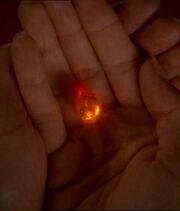
A transporter tag given to Kira Nerys
By the 24th century, usage of pattern enhancers was common aboard most Starfleet vessels, most often deployed to a planet's surface during emergency situations where transport was critical.
Devices that were specifically designed to block transporter signals or to interfere with them were usually deployed under hostile conditions, thus making use of a transporter impossible or very dangerous and hampering maneuverability of personnel or material. Some of these devices were:
- Transporter scrambler
- Transport inhibitor
- Remat detonator
- Scattering field
In 2375 , Vedek Fala gave a small crystal to Colonel Kira Nerys , as a gift. The device, of unknown origin and design, was actually a transporter tag , which instantly transported her to Empok Nor , several light years distant. ( DS9 : " Covenant ")
Also, in 2293 , Spock used a viridium patch to locate and lock on to Captain Kirk and Dr. McCoy on Rura Penthe . While not a transporter device, it was used to locate the subject with the transporter. ( Star Trek VI: The Undiscovered Country )
Transporting the injured [ ]
Although someone with minor injuries could be transported, this was not possible when the injuries were extensive. When the brain stem was damaged and autonomic functions were failing, transport was only possible if a volunteer controlled the person's autonomic functions. This was done by placing a neural pad at the base of the skull of both individuals and then connecting both people via a medical tricorder . This way, autonomic functions could be stabilized for a short period of time, making transport possible. ( TNG : " Transfigurations ")
In 2372 , Odo began to experience the effects of an unknown affliction that he had acquired from his fellow Changelings , which caused the destabilization of his molecular structure . When it was proposed that he be ferried aboard the USS Defiant to the Founders' new homeworld , the crew had to wait for Odo to carry himself aboard the ship. When it was questioned why he couldn't go through the transporter, Doctor Julian Bashir explained that " his molecular structure is scrambled enough as it is, " adding, " [t]he last thing he needs is a trip through a transporter buffer . " ( DS9 : " Broken Link ")
Special operations [ ]
Automatic return [ ].
As of 2269 , transporters could be set to automatically beam back an individual after a prearranged amount of time . In 2269 , James T. Kirk asked Montgomery Scott to set automatic return for ten minutes . ( TAS : " The Terratin Incident ")
Disabling active weapons [ ]
By the 24th century, the transporter had the capability to disable any active weapon during transport. This could be accomplished by removing the discharged energy from the transporter signal, or by "deactivating" the weapon itself. The transporter system included weapons deactivation subroutines to control the process. ( TNG : " The Most Toys ", " The Hunted ", " Rascals ")
The transporter was also capable of removing weapons entirely during transport, a setting referred to by Starfleet as "Transport Protocol Five". When the Defiant beamed aboard survivors from a damaged Jem'Hadar ship, the transporter was programmed to remove the crew's disruptors and other weapons. ( DS9 : " To the Death ")
Falsifying disintegration by a phaser [ ]
Although transports usually took several seconds to complete, it was possible to transport an individual to safety a split-second before they were to be struck by a phaser beam, making it appear as though they had been disintegrated. By 2373 , Section 31 had access to such technology and used it to fake the death of operative Luther Sloan in front of the Romulan Continuing Committee . Since William Ross later told Julian Bashir that Tal Shiar chief Koval had fired a phaser at Sloan, rather than a disruptor pistol , it is likely the weapon had been specially modified and was integral to creating the illusion. ( DS9 : " Inter Arma Enim Silent Leges ")
Connecting two transporters [ ]
Two transporters could be bridged together by means of a system interlock to facilitate direct transport between them. Federation vessels could activate other Federation vessels' transporters remotely by means of this. This meant that two transporters could be connected to each other to allow beaming in situations where it would otherwise not be possible due to ionic or some other type of interference. ( TNG : " Symbiosis ", " Realm Of Fear ")
First, a remote link to the other transporter had to be established, then the system interlock needed to be engaged and the pattern buffers of both transporters were synchronized. When the phase transition coils were in stand-by mode, energizing could commence.
A side-effect of using this form of transport to beam through ionic interference was that the person who was beamed might feel a slight tingling, due to static. ( TNG : " Realm Of Fear ")
Intraship beaming [ ]
In the mid- 2260s , beaming from a transporter pad to a location within the same vessel was a very risky proposition. The limitations of the technology at that time made it highly probable that any error would result in the subject rematerializing within a bulkhead, deck, or other structure. As such, the procedure had rarely been attempted. ( TOS : " Day of the Dove ") The first occurrence of this procedure was used without incident, a century earlier. ( ENT : " Chosen Realm ")
The reasoning for the difficulties in intraship beaming was not stated. A technology capable of transporting a subject over thousands of kilometers without error should be able to do so over a few dozen meters easily, though one could speculate that the emitters are focused away from the ship, as shown in the technical manuals.
From the writing standpoint of the episode itself, though, if such capability did exist, then it would have been an easy matter to free the trapped crewmen in the lower decks.
In 2364 , Commander William T. Riker and Lieutenant Tasha Yar used intraship beaming during a rescue. When cargo instead of passengers was beamed aboard, Riker ordered Yar to beam the cargo to the hold. ( TNG : " Symbiosis ")
Intraship transport was apparently both safe and commonplace by the 2360s, as, beyond the aforesaid example, the technique was used a number of times aboard the USS Enterprise -D :
- Captain Jean-Luc Picard and First Officer Riker both beamed from a transporter room directly onto the bridge . ( TNG : " 11001001 ")
- When several Bringloidi were beamed aboard, carrying assorted farm animals, Picard ordered them beamed into Cargo Hold 7. ( TNG : " Up The Long Ladder ")
- While escaping a mind-controlled crew, Wesley Crusher engaged a program that beamed him from Deck 36 to Transporter Room 3. ( TNG : " The Game ")
- Ambassador Ves Alkar 's assistant, Liva , was beamed away from her quarters on command from Captain Picard to prevent her being used by Alkar. ( TNG : " Man Of The People ")
- When rogue Ferengi briefly took over the Enterprise , a plan was devised to capture them by beaming them one-by-one onto a transporter pad secured by a force field . ( TNG : " Rascals ")
- Picard, Riker, and several others transported from a shuttle in its bay directly to the observation lounge . ( TNG : " Gambit, Part II ")
In the first draft script of DS9 : " Emissary ", Benjamin Sisko desperately suggested using intraship beaming to rescue the body of his deceased wife Jennifer Sisko from wreckage aboard the USS Saratoga during the Battle of Wolf 359 . He was told by his Bolian security officer , however, that none of the Saratoga 's transporters were functional. This discussion was excluded from the revised final draft of the episode's script. [3]
"Site-to-site" transport [ ]
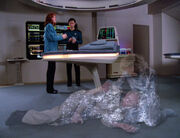
Beaming directly to sickbay
- See : Site-to-site transport
The earliest known example of site-to-site transport carried out by Federation personnel occurred in 1986 , though the transporter was on board a vessel that had traveled back in time from 2286 . The craft which possessed site-to-site capabilities was Klingon in origin but had been stolen by the crew of the late starship Enterprise . ( Star Trek IV: The Voyage Home )
By at least 2268 , limitations in pattern buffer and targeting scanner technology had been sufficiently overcome that it was now possible to transport from one location directly to another without the need to re-materialize the subject in between. ( TOS : " A Piece of the Action ") In the 24th century, this operation was enabled and controlled by the site-to-site transport interlocks . ( TNG : " Brothers ")

A Klingon transporter performs a site-to-site transport
Transporter systems had to be manually configured to prepare for site-to-site transport. This included resetting the pattern buffer controls and checking the targeting scanners. ( VOY : " Twisted ")
Site-to-site transport held the matter stream in the pattern buffer while the ACB was re-targeted. Afterward, the matter stream was redirected to the new location and normal re-materialization was carried out.
Using this technique, any computer terminal with access to the main transporter sub-systems, or any applicable subroutine, could be used to control transporter operations, including bridge terminals. This technique could only be utilized when sufficient energy was available to the transporters; all normal transporter limitations would still apply. ( Star Trek Nemesis )
This procedure was particularly useful in emergency medical situations where time was of the essence. Subjects could be beamed directly to sickbay , where treatment could be carried out quickly. ( TNG : " Tapestry "; Star Trek: First Contact )
In 2368 , Ensign Wesley Crusher used this method in an attempt to outrun those (especially Riker and Worf) whose minds had been taken over by a Ktarian game . ( TNG : " The Game ")
Seven of Nine once initiated a site-to-site transport into Chakotay's quarters. Instead of the door chimes sound, the comm tone is heard (not the boatswain whistle.) She thinks it would be inappropriate to be seen carrying flowers to the first officer's quarters. ( VOY : " Endgame ")
Transporter trace [ ]
By the 23rd century , it was common practice to store a "transporter trace" (a stored copy of a subject's molecular pattern as scanned during a normal transporter cycle). While it was usually kept for security purposes, in extreme situations, the transporter could be modified to use an older trace pattern in place of the latest scan for the purpose of re-configuring the matter stream during molecular conversion, effectively replacing a subject with a younger version of itself during matter re-construction. The first known use of this technique was in 2270 , when it was used to restore the crew of the USS Enterprise , whose aging had been reversed to their adult versions. ( TAS : " The Counter-Clock Incident ") Another notable use of a transporter trace was in 2364 , to restore Captain Jean-Luc Picard after an unsuccessful attempt by an alien energy being to merge with him. ( TNG : " Lonely Among Us ")
The transporter trace itself was regularly stored for the duration of the person's tour of duty; when that person was reassigned, his or her trace was deleted. ( TNG : " Unnatural Selection ")
When necessary, a person's DNA could be used to create a transporter trace. This technique was utilized by Chief Miles O'Brien and Lieutenant Geordi La Forge during a mission to the Darwin Genetic Research Station in 2365 .
Transporter traces were also used as a medical tool, to help in spotting anomalies at the molecular level. When comparing the transporter ID traces of Deanna Troi , Data and Miles O'Brien before and after they were taken over by Ux-Mal criminals, Doctor Beverly Crusher was able to detect that their nervous systems were generating high levels of synaptic and anionic energy . ( TNG : " Power Play ") Another example of such an application was in 2373 , when The Doctor used Harry Kim 's transporter trace records to determine when he had been infected with Taresian DNA. ( VOY : " Favorite Son ")
Deflecting the transporter beam [ ]
A transporter beam could be deflected to different coordinates by a tractor beam , so that the objects being transported would rematerialize at a point other than the intended target coordinates. Such action could only be detected by examining the transporter log . An unusual amount of antigraviton particles would be present in the emitter coil , as those particles do not occur naturally but are used by tractor beams. Locating the coordinates at which rematerialization took place was not possible; however, it was possible to calculate the point of origin of the tractor beam itself. ( TNG : " Attached ")
Single-person transport [ ]
A transporter could be programmed to only allow one particular person to be transported to and from the transporter pad . Thus programmed, no other persons could use the transporter. If the use of the transporter was further prohibited, by use of an unknown access code, using the transporter was almost impossible.
The only way to circumvent this lock-out was to use the transporter trace from the person who re-programmed the transporter and to input this into the transporter while it was in its testing mode. When in testing mode, a transporter would accept simulated inputs. When the main computer could not be used, several tricorders could be networked together to control the transporter. To circumvent the lock-out, access codes from a few bridge officers were necessary to force it in a recall loop. Consequently, anyone and everyone who transported would be seen by the transporter as the person who had re-programmed it in the first place. ( TNG : " Brothers ")
Faking a transporter accident [ ]
A transporter accident could be faked in such a way that a transporter chief would think a person died during transport. For example, this could be done by adjusting the carrier wave of a second transporter to the carrier wave of the first. The person would then beam off the first transporter while the second transporter beamed in a small amount of genetically identical material.
Only a doctor could determine if this material was really the person in question. The transporter trace could be used to compare the logged DNA pattern "trace" to the "dead" person. Single-bit errors might be detected, if the "dead" material was replicated .
Only transporters that operated on the same subspace frequency as the spoofed transporter can be used for this type of ruse. For example, some Romulan transporters were capable of this.
Another indicator of such a ruse would be a temporary increase of the matter to energy ratio, while transport was in progress. However, this increase could fall within the nominal operational parameters of the transporter in question. Investigation of the transporter logs would be necessary to find evidence of a second transporter signal. ( TNG : " Data's Day ")
Emergency mass beaming [ ]
Some transporters could transport large numbers of people, and either rematerialize them simultaneously or in groups. However, this was not often done, due to safety reasons. In 2268 , the crew of the USS Enterprise used their transporters in this manner to capture members of the crew of a Klingon ship. In 2377 , the USS Voyager transported over two hundred Klingons off a battle cruiser by expanding the transporter's buffer capacity. In 2380 , Ensign Sam Rutherford used a single transporter room on the USS Cerritos , reconfigured with experimental settings, to simultaneously beam the entire crew of the USS Rubidoux on board. The transportees were left with undesirable cosmetic side effects, but which were temporary, and they were otherwise perfectly fine. ( TOS : " Day of the Dove "; VOY : " Prophecy "; LD : " Much Ado About Boimler ")
Narrow confinement beam [ ]
Setting a transporter's annular confinement beam to a narrow width would sometimes allow it to penetrate some types of shielding or other interference. One noteworthy application of this was to penetrate Borg shields, a procedure developed by scientists Magnus and Erin Hansen . ( VOY : " Dark Frontier ")
Skeletal lock [ ]
USS Voyager Chief Engineer B'Elanna Torres invented an emergency measure of locking a transporter beam onto minerals in the target's skeletal system, in order to allow transport when bio-signs could not be detected from transporting origins. This allowed personnel to be transported back to the ship, even if regular means of transporter lock failed. She came up with it after a conventional signal lock failed, during an emergency beam-out from a Borg cube in 2373 . ( VOY : " Scorpion ")
Offensive use [ ]
In 2373 , Nyrians used a long-range transporter to take control of the USS Voyager by beaming aboard the ship one person at a time, replacing a member of the crew in the process. Initially feigning ignorance and confusion, the Nyrians did not raise suspicion until they had already outnumbered the Voyager crew. By then, however, it was too late; the Nyrians commandeered Voyager and incarcerated the crew inside a simulated Earth-like environment aboard a massive prison ship . It was later revealed that this was an often-used Nyrian strategy, as it was far less costly than engaging in open hostilities. ( VOY : " Displaced ")
In 2374 , pirates used transporters to steal the USS Voyager 's main computer and other critical equipment, rendering the ship's weapons, navigation and propulsion inoperable. This led Tom Paris to remark, " I feel like we've just been mugged. " ( VOY : " Concerning Flight ")
The Vulcan Chu'lak modified a projectile weapon by adding a micro-transporter, allowing him to fire bullets through walls into other rooms. ( DS9 : " Field of Fire ")
In the final draft script of ENT : " Detained ", Commander Tucker hatched a plan to beam concussive charges into guard towers at Detention Complex 26 . In the final version of the episode, though, he opts for an entirely different attack strategy.
Medical transports [ ]
- See : Fetal transport
According to the DVD audio commentary for the film Star Trek , in early drafts of that movie, the transporter would have played a role in the birth of James T. Kirk , though it also would have created another loss – in an emergency, it was possible to beam a child out of a womb, but, being an "inexact science," this came at the cost of the mother's life. While J.J. Abrams thought it was a "really cool" idea that the technology could be used in this way, the plan was dropped because the production staff didn't want to introduce the transporter so early in the film, and felt that the end of such a traumatic opening scene needed the "victory" of Winona Kirk 's survival.
Rematerialization without clothes [ ]
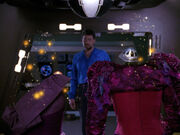
Beamed from their dresses
During Chakotay 's Starfleet career, he was involved in a transporter malfunction. His uniform ended up in a pattern buffer ; he materialized wearing only his combadge . ( VOY : " In the Flesh ")
Removal of clothing using a transporter can also be done deliberately, as a group of Ferengi did to Deanna and Lwaxana Troi in 2366 . ( TNG : " Ménage à Troi ")
Other operations [ ]
- Transporter Code 14
- Near-warp transport
Appendices [ ]
Background information [ ], origins [ ].
The transporter was developed by the production staff of the original series as a solution of how to get crewmen off a planet quickly. The only alternative was to either land a massive ship each week, or regularly use shuttles for landings, both of which would have wreaked havoc on the production budget. ( Star Trek Encyclopedia , 3rd ed., p. 519) Although both of these were proposed in the initial draft of the series outline Star Trek is... (with regular shuttlecraft landings and rare descents of the ship), a revision of the same document (as reprinted in The Making of Star Trek , pp. 22–30) contained one of the first examples wherein the concept of the transporter was outlined. ( [4] ; The Making of Star Trek , p. 26) The description posited a not-yet-named "energy-matter scrambler which can 'materialize' [landing parties] onto the planet's surface." The outline went on to say, " This requires maximum beam power and is a tremendous drain on the cruiser's power supply. It can be done only across relatively short line-of-sight distances. Materials and supplies can also be moved in this same manner, but require a less critical power expenditure. " ( The Making of Star Trek , p. 26)
Gene Roddenberry considered the invention of the transporter to be highly fortunate and " one of many instances where a compromise forced us into creative thought and actually improved on what we planned to do. " He further explained, " If someone had said, 'We will give you the budget to land the ship,' our stories would have started slow, much too slow [....] Conceiving the transporter device [...] allowed us to be well into the story by script page two. " ( The Making of Star Trek , pp. 43–44)
The script of " The Cage ", the first Star Trek pilot episode, referred to the transporter as consisting of a device that dominated the transporter room and "could be an artist's nightmare-conception of a futuristic x-ray machine," as well as a "glassed-in transporter chamber" that the device hovered over.
The depiction of the transporter in TOS : " The Man Trap " was instrumental to that installment becoming the first to ever be broadcast. Though "The Man Trap" writer George Clayton Johnson was unaware of this at the time, Herb Solow informed him, years afterwards, of the transporter's importance in convincing the executives at NBC to air "The Man Trap" first. Johnson relayed, " He told me, 'By going with yours, we were able to open the series with the crew getting aboard the transporter device and beaming down to the planet. By letting the audience watch the transporter in action, and letting them see the crew materialize and dematerialize, we were saved from having to try to explain it.' " ( George Clayton Johnson – Fictioneer , " Star Trek ")
In an early written version of TOS : " What Are Little Girls Made Of? ", the transporter was described as an "energy matter scrambler" (matching how it had been characterized in the aforementioned revised draft of Star Trek is... ). In a series of research notes (dated 11 May 1966 ), however, Kellam de Forest pointed out, " 'Scramble' implies that objects are mixed in an unorganized fashion. The transporter converts the matter of the body into energy. " As a result, de Forest suggested instead referring to the transporter as an "energy matter converter."
Arthur Singer , the story editor for the third season of TOS, had some uncertainty about the function of the transporter, which he expressed around three months after D.C. Fontana left the series as story editor. Regarding how Singer voiced his confusion about the device, Fontana recalled, " [He] wandered onto the set and asked our set decorator, 'By the way, what does that transporter thing do again?' "
The series writers' guide (third revision, dated 17 April 1967 ) stated about the transporter, " Its range is limited to about 16,000 miles. " [5]
The writers/directors guide for Star Trek: Phase II contained the exact same statement. ( Star Trek Phase II: The Lost Series , p. 96) For that series, a "transporter station" was to have been incorporated into the Enterprise bridge, complete with a working transporter. ( Star Trek Phase II: The Lost Series , p. 20) This was to have served as an equipment transporter, for beaming such things as small tools to the bridge. ( text commentary , Star Trek II: The Wrath of Khan (The Director's Edition) DVD ) On 13 October 1977 , Gene Roddenberry posited that transporters of Phase II would be able to beam through the Enterprise 's force field when it was fully raised, by opening a section of the force field in order to make it weak or moderate. ( Star Trek Phase II: The Lost Series , p. 50) However, the writers/directors guide for the series clarified that the Enterprise 's transporter could not be operated while the ship's deflector screen was in operation. ( Star Trek Phase II: The Lost Series , p. 97)
Gene Roddenberry briefly considered – early one day, while Star Trek: The Next Generation was in preproduction – vastly increasing the power of the transporter in The Next Generation to such an extent that no main starship was to have been featured in that series. This unusual suggestion was scrapped by the end of lunch on that particular day.( Star Trek: The Next Generation - The Continuing Mission 1st ed., p. 14) David Gerrold argued against it, pointing out that the Enterprise was necessary for Star Trek to be successful because the ship was "the star of the show." Added Gerrold, " He says, 'Okay. Just throwing that out.' " ( Stardate Revisited: The Origin of Star Trek - The Next Generation , Part 1: Inception , TNG Season 1 Blu-ray special features) Also during the development of TNG, some consideration was given to the possibility of featuring a transporter on the Galaxy -class bridge, though this idea was soon dropped in favor of turbolifts. ( Starlog issue #125, p. 46) Since David Gerrold had listed (in his book The World of Star Trek [ page number? • edit ] ) transporter malfunctions as being a too-overused plot device in the original series, Roddenberry intended to correct this in TNG. ( Star Trek - Where No One Has Gone Before paperback ed., p. 110)
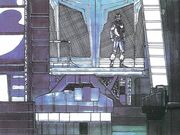
The concept sketch of DS9's transporter by Ricardo Delgado
The transporter and the term "beam" were so relatively easy to account for that they were among multiple reasons for Rick Berman and Michael Piller deciding that a new science fiction series they were asked to create, which ultimately became Star Trek: Deep Space Nine , would be in the Star Trek mold, rather than a brand-new show. Since the design parameters of the series were very well defined, putting a Starfleet-usable transporter aboard space station Deep Space 9 turned out to be "not difficult at all," in Production Designer Herman Zimmerman 's words. The transporter in the station's Operations Center was designed by Ricardo F. Delgado and illustrated in a concept sketch by him. ( The Official Star Trek: Deep Space Nine Magazine issue 3 , p. 6) The creators of the then-new show opted to rely on the fact that transporters had already been established earlier in the Star Trek franchise. " We won't reinvent the transporter – everyone knows how the transporter works, we don't have to explain that any more, " stated Zimmerman. ( Trek: Deepspace Nine , p. 52)
The concept of a long-range transporter was again briefly considered, upon initial development of TNG's final episode, " All Good Things... ". The scene in which it was to be used was soon omitted , though. ( Star Trek: The Next Generation Companion , 3rd ed., p. 301)
A transporter was originally not budgeted for inclusion aboard the Defiant -class , which was introduced at the start of DS9's third season . At one stage, however, Herman Zimmerman expected that, as stories and budgets warranted it, transporter facilities would later be added to the Defiant -class. ( Cinefantastique , Vol. 27, No. 4/5, p. 97) A transporter for that class was indeed created, designed by Jim Martin . ( The Art of Star Trek , p. 112) It debuted in season three's " Past Tense, Part I ".
While Star Trek: Enterprise was in development, Executive Producer Brannon Braga initially wanted there to be no transporter on Enterprise NX-01 , though this idea was disputed by executives at Paramount . " [He] thought transporter technology is in the future, " explained André Bormanis , regarding Braga's viewpoint. " Well [...] this became a point of contention with, you know, the powers that be. The compromise we reached was that, okay, it's got a transporter, but it's experimental technology, and they don't really want to use it unless they absolutely have to. And we thought, in the 22nd century, it ought to be more challenging, or better yet, let's not introduce it in the first season . Maybe the second season , they'll upgrade the ship. " ("To Boldly Go: Launching Enterprise , Part I: Countdown", ENT Season 1 Blu-ray special features)
An even earlier transporter had to be depicted in the film Star Trek Beyond , for the 22nd century vessel USS Franklin . Doug Jung , who co-wrote the movie, once commented, " Back then, they didn't actually have Human transporters, you couldn't beam a Human up. So we had to put a line in where Scotty says, 'I made these recalibrations.' " [6]
Sets and props [ ]
The "psychedelic" back wall of the TOS transporter was actually made from reflective, translucent plastic known to musicians as "Drum Wrap" since it's commonly used to adorn the outer cylinders of drum sets. The same plastic later went on to be incorporated into intercoms regularly featured on Star Trek: Enterprise . (" Stigma " text commentary , ENT Season 2 DVD )
The TOS transporter had a "built-in top and bottom lighting setup for the beaming up/down effects," stated Robert H. Justman . ( Star Trek: The Magazine Volume 1, Issue 17 , p. 13) The transporter pads from TOS were simple Fresnel lenses . John Dwyer , a set decorator who worked on both TOS and TNG, explained, " In the original series, the lights in the platform under the round rings were curved lenses, polished in such a way as to make the light really bright, like you have in lighthouses; but they also use them in the bigger stage lights, and that's what these were. " ( Star Trek: The Magazine Volume 2, Issue 12 , p. 25) (See this Flash recreation from a scene deleted from " Mudd's Women " for an indication of the luminosity of a 10,000 watt Fresnel lens.) These components were the only part of the transporter set that remained when the set was redesigned for Star Trek: The Motion Picture . ( audio commentary , Star Trek: The Motion Picture (Blu-ray) ) The Next Generation also used the lenses as the units in the ceiling directly over the pads. ( The Art of Star Trek , p. 78) Dwyer recounted, " [Production Designer] Herman [Zimmerman] said, 'Hey, that's a good idea; let's just keep it!' So we did. " ( Star Trek: The Magazine Volume 2, Issue 12 , p. 25) The same components were additionally included in the transporter of the USS Voyager in Star Trek: Voyager . ( The Art of Star Trek , p. 78) Michael Okuda remembered, " One day during, I think, Voyager , I happened to be working in the catwalks above the set and I was looking at those lenses. Five of them looked yellowed and chipped, so I believe that they were from the original series. One of them looked a lot newer. " (audio commentary, Star Trek: The Motion Picture ( Blu-ray ))
The equipment transporter proposed for the Enterprise bridge of Star Trek: Phase II was actually built. One remnant of its construction, a square arrangement of four green lights, was incorporated into the Enterprise bridge of Star Trek II: The Wrath of Khan . The Regula I transporter in that film involved spotlights reflecting off a glitter ball behind the set, a simple way of achieving the effect of energy patterns on the transporter chamber's back wall. (text commentary, Star Trek II: The Wrath of Khan (The Director's Edition) DVD)
The faint pattern on the insides of the TNG transporter took its inspiration from a sweater owned by Herman Zimmerman, who created the pattern while prepping TNG. Interested in doing something different from the psychedelic moire patterns of the original series' transporter but not having liked any of the patterns that he or his staff devised for potential use, a frustrated Zimmerman finally took off his sweater and declared, " Here, this is what we'll use! " The pattern was thereafter incorporated into the design of the Enterprise -D's transporter, which was reused as the Enterprise -A's transporter in Star Trek V: The Final Frontier and Star Trek VI: The Undiscovered Country . ( text commentary , Star Trek VI: The Undiscovered Country (Special Edition) DVD )
For Star Trek Generations , the transporter of the Enterprise -D was given a new interior lighting scheme that included the addition of amber gels behind some of the upper transporter lenses from TOS. ( The Art of Star Trek , p. 278) Because the original panels from the TNG transporter's back wall had somehow been damaged during preproduction on the film, they were replaced by new but virtually identical panels. ( text commentary , Star Trek Generations (Special Edition) DVD )
At least one of the floor panels from the Enterprise -D transporter was reused as a serving tray in Quark's Bar, Grill, Gaming House and Holosuite Arcade in Star Trek: Deep Space Nine . ( Secrets of Quark's Bar , DS9 Season 1 special features)
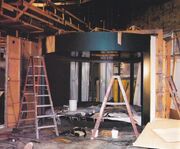
The Intrepid -class transporter set being created for Star Trek: Voyager
According to Star Trek: Communicator , the Intrepid -class transporter incorporated "vertical edge-lit Plexiglas and spiky sonic foam lining the walls." ( Star Trek: Communicator issue 111 , p. 52) According to Kim actor Garrett Wang , the Intrepid -class transporter ceiling used on the set of Star Trek: Voyager was the original ceiling used on Star Trek: The Motion Picture . ( E! Inside Star Trek: Voyager , at 21 minutes)
The floor and ceiling of the transporter aboard the NX-class Enterprise were inspired by the fresnel lenses of TOS. (" Broken Bow " text commentary , ENT Season 1 DVD ) Similarly, the sides of the ENT transporter were deliberately evocative of the walls of the TOS Enterprise transporter. ( Broken Bow , paperback ed., p. 268)
Special effects [ ]
- See : Transporter sound and visual effects
The transporter is the only technology which is commonly used in Star Trek productions but which André Bormanis , at least as of 1996 , deemed as "a real stretch" of the imagination. " The Heisenberg uncertainty principle makes it impossible to know the exact location and energy of any particular subatomic particle. Therefore, were you to disassemble a person as the transporter does, it may well be impossible to put them back together again, " he explained. " We have reason to believe that this is because of some very basic physical facts about the universe and there's no way to get around that. " ( Captains' Logs Supplemental - The Unauthorized Guide to the New Trek Voyages , p. 76)
Although the catch phrase " Beam me up, Scotty " has worked its way into pop culture , the exact phrase itself was never uttered in Star Trek: The Original Series . ( Star Trek Encyclopedia , 3rd ed., p. 39) The closest usage to the phrase came in Star Trek IV: The Voyage Home , when Kirk requests, " Scotty, beam me up. " Similarly, in " This Side of Paradise ", Kirk states, " Beam me up, Mr. Spock. " Only two other instances have used unqualified references to the phrase " Beam me up " – " The Squire of Gothos " and " Time's Arrow ".
According to Michael DeMeritt , the performers who portrayed persons who were beamed up were frequently thrilled to do so. He stated, " This is every actor's dream, whoever gets on Star Trek . 'Please, beam me up.' " ( ENT : " North Star " audio commentary , ENT Season 3 DVD ) Veteran Star Trek actor Vaughn Armstrong cited the transporter as his "favorite piece of Trek tech" and said, " I can't think of anything better. " Similarly, when Pat Tallman was asked what her favorite technology from the franchise was, she included in her answer the rhetorical question, " Who doesn't wish for the transporter? " ( Star Trek Monthly issue 90 , pp. 31 & 32)
Initially familiarizing themselves with the workings of the transporter presented a challenge for some of DS9's principal cast members. As a result, one of several questions O'Brien actor Colm Meaney was asked by his fellow DS9 performers, he having had more Star Trek experience than them by having played O'Brien as a recurring character in TNG , was " How does the beam down work? " ( The Official Star Trek: Deep Space Nine Magazine issue 1 , p. 23)
On one specific early occasion, Jake Sisko actor Cirroc Lofton enjoyed familiarizing himself with not only the transporter but also the sets of TNG and DS9. " No one was there. So, I started fiddling around with things and beaming myself up, " he reminisced. ( The Official Star Trek: Deep Space Nine Magazine issue 5 , p. 49)
Brannon Braga believed that using a transporter in ENT : " Vanishing Point " to explain a hallucination was "a great twist." However, some fans deemed it "a cop-out," in Braga's words. ( Star Trek: Communicator issue 145 , p. 26)
In Star Trek Adventure , where volunteers were picked from the audience, there was an optical illusion using lens distortion to simulate the transporter, which was then further edited to video for purchase after the show.
Apocrypha [ ]
In The Worlds of the Federation (p. 16), the first transporting of a Human is said to have taken place in the transporter room of the USS Moscow .
A partial explanation for the difference between transporters between Star Trek and Star Trek: The Next Generation is provided in the Pocket TNG novel Dark Mirror , where the Enterprise -D encounters a mirror universe where the Terran Empire continues into the 24th century; when discussing the original crossover, Chief Miles O'Brien notes that transporters in Kirk's era were essentially more powerful, but a lot less sophisticated, with people lacking knowledge of how some spatial anomalies would affect the system even if its sheer power tended to compensate for those shortcomings.
In the novel adaptation of " Broken Bow ", it is said that, before the verb of "beam" had been accepted for describing the process of transporting, Starfleet had considered the words "scramble", "heat," "disassemble," and "spear," although "beam" had been considered the least frightening term.
In the short story "Our Million-Year Mission" from the anthology book Strange New Worlds VI , the transporter had been replaced by a more advanced system known as the blinkporter that was capable of instantaneously transporting a person to any temporal or spatial destination by the year 1,012,260.
An additional piece of transporter technology was developed in the alternate reality . Known as the "engineering transport tool ( β )", or ETT, it consisted of a rifle that could tag objects or individuals and transport them short distances. In the 2013 video game Star Trek , James T. Kirk and Spock use this tool to bypass areas of the Frontier starbase that have been damaged by the Gorn 's attack.

External links [ ]
- Transporter at Memory Beta , the wiki for licensed Star Trek works
- Transporter (Star Trek) at Wikipedia
- Notable Transporter Mishaps (X) at StarTrek.com
- 1 Daniels (Crewman)
- 3 World War III
Transporters, Replicators and Phasing FAQ
Last modified: Wednesday, 23 February 2005 10:05 PM -0800 Maintained by: Joshua Bell , [email protected] Archive site (WWW): http://www.calormen.net/Star_Trek/ FTP site (text versions): ftp://ftp.cc.umanitoba.ca/startrek/minifaqs/
Copyright � 1994-2003, Joshua Bell. Not in the public domain. Permission to distribute this document, unedited and including this copyright notice is granted, provided no fees are charged for access beyond charges for downloading or connection time from a commercial information service. Publication of this document in a magazine or journal (in any media format) must be approved by the author.
Star Trek �, Star Trek: The Next Generation � , Star Trek: Deep Space Nine � and Star Trek: Voyager � are trademarks of Paramount Pictures registered in the United States Patent and Trademark Office.

1. Transporters
2. replicators.
- 5. References
"How does the transporter work?"
While there is no absolute canonical answer, we can piece one together from various clues, that fits nearly everything seen on-screen, and in the TNG Tech Manual.
We have some evidence of the inner workings of transporters, but not much. They employ Heisenberg compensators, pattern buffers, phase transition coils, Biofilters, matter streams, confinement beams, and matter-energy converters, and phased matter. As for what they do, we know that you are conscious during transport ( Star Trek II: The Wrath of Khan , "Realm of Fear" [TNG] ), but can also be held in stasis ( "Day of the Dove" [TOS] , "Relics" [TNG] ). Further, while in transport, you appear whole to yourself.
I hypothesize that the Annular Confinement Beam first locks onto, then disassembles the subject into phased matter, via the phase transition coils, causing it to take on a very energy-like state somewhat akin to plasma, called phased matter. The matter stream is then fed into the pattern buffer, piped through wave-guide conduits to one of the beam emitters on the hull of the starship, and then relayed to a point on the ground where the ACB reconstructs the subject.
"Excuse me, Annular Confinement Beam?"
Yes. The ACB is where the phrase "Beam me up, Scotty!" comes from. The beam serves two purposes: The first is to maintain a "lock" on the subject, so the transporter knows what to beam out, and what to leave behind. The second purpose is to do the actual transporting, whilst keeping the subject in one piece subjectively.
"How does the transporter know what to take and what to leave?"
In "The Enterprise Incident" [TOS] , the ship's scanners are able to differentiate a Vulcan from all of the Romulans aboard another ship. They are very sensitive, but also take a great deal of time. In many episodes, this sensitivity is not used. However, to scan at that level of resolution would take perhaps far longer than the crew has.
In any case, the ACB generators are able to scan the target subject, and either using some best-guessing or asking the Transporter Chief, decide what should be transported with the subject.
As one r.a.st.tech poster put it, "One to beam up, hold the bunny slippers." :)
"So what is this pattern thing?"
The pattern buffer is a cyclotron-like tank (TNG:TM) which holds the whirling matrix of phased matter in the ACB while the subject is beamed out and beamed in. In order to keep track of where every part of the subject is, the computer constructs a pattern to keep track of what bits of the stream end up where.
An analogy would be the [left->right->left&down]->top pattern a television electron gun follows to paint a picture on the phosphors of the screen. The television (we're assuming an old analog no-frills model) doesn't know and can't possibly store the information needed to construct a one-hour program, but it has a pattern, and uses a modulated matter (electron) stream to do it.
In "Lonely Among Us" [TNG] , Picard is recovered from being beamed away as pure energy. The computer is able to reconstruct Picard by using the pattern it had stored, working with the phased matter stream that Picard's energy state itself supplied. Since the pattern was pre-transport, the reformed Picard had no memories of the excursion.
Similar to this is the transporter ID trace, which is kept for verification purposes for a long time after transport. This is probably a highly compressed sample of the pattern, plus the name of the transportee, logs of the transport cycle, etc. (TNG "Data's Day" .)
"So what is a Heisenberg Compensator?"
As Mike Okuda said when asked by Time (28 Nov 1994), "How do the Heisenberg compensators work ?" "They work just fine, thank you." [Benjamin Chee]
In physics, the Heisenberg Principle states that you cannot know both the position of a subatomic particle and its momentum to a precise degree. The more you know about one, the less you know can about the other.
This comes into play when you consider that to know where everything is coming from and going to, you pretty much have to know near-exactly where everything is. By the 24th century, evidently, that's no longer a problem. The Heisenberg Compensators are probably used to keep everything in the matter stream exactly where it should be.
Note that this doesn't mean that the Heisenberg Compensators tell you the vital statistics of the particle; they could very well just compensate for not knowing them and keep the system working just fine, thank you.
"How does that Biofilter gadget work?"
The Biofilter is a good clue as to how the transport patterns work. The filter looks for elements of the pattern which aren't found in normal beings/equipment, or those of known viruses and bacteria. It can simply erase those parts of the pattern, and those parts of the matter stream won't beam back in.
In "Unnatural Selection" [TNG] , Pulaski is restored from an aged state by the use of the Biofilter. If Pulaski's altered DNA could be tagged as unwanted, the pattern could be tweaked to restore the DNA (its pretty much all the same molecules anyway, just shuffle some base-pairs around). As for her recovering instantly... well, it's a TV show.
"What is pattern degradation?"
The pattern is probably highly complex. Pattern degradation occurs because the Annular Confinement Beams aren't perfect, even with the help of the Heisenberg Compensators. The matter stream comes out of alignment with the computer's pattern predictions for where things should be. Obviously, this is a bad thing.
According to the TNG Tech Manual, a subject can be suspended in transport for up to 420 seconds before the degradation is too severe to attempt to reform the transportee. They push close to this limit in "Realm of Fear" .
In "Relics" [TNG] , we see that by keeping the transport controller locked in a diagnostic loop, pattern degradation is kept to a minimum - even with an old-style transporter, only 0.003% of the pattern was lost after 75 years in stasis.
In "Realm of Fear" [TNG] , the most extraordinary development is the reconstruction of the lost crew, and their appearance as the giant slugs while in transport. I suspect that the phased-matter "bugs" which reside in the plasma environment act as a natural ACB, maintaining the pattern of those "lost" in transport. The computer is able to use the Biofilter to rebuild the patterns and restore the individuals.
"Where are you during transport?"
Inside the ACB. "Realm of Fear" [TNG] shows what it looks like - lots of blue and silver sparkles. If you mean from an outside observer's point of view, you're either in one of the pattern buffers, or in transit to the beaming coordinates. In "The Gamesters of Triskelion" [TOS] , Kirk and crew are lost during transport. In the technobabble that follows, Spock and McCoy discuss whether recovering the lost crewmembers from the transport beam, thought to be zipping away from the Enterprise, is possible. This means that if the beam was somehow suspended, a smart computer could reconstruct the pattern and beam you back in. This might be what happened in "Realm of Fear" [TNG] . If the ACB environment is similar to a plasma field, the bugs could act as stabilizers. Long shot, but hey.
"So was Scotty conscious for 75 years?" ( "Relics" [TNG] )
Nope, or he would have starved - if your brain is working, your heart must be pumping blood, and it needs energy from somewhere. There are three possibilities for how this was accomplished:
1) All transporters have an optional "stasis" switch, that locks the pattern of the subject during transport. In other words, they are frozen on a quantum level.
2) Old-style transporters, as seen in TOS, always transported the subject under stasis. From watching the show, we can see the two stages in a bream-out. First, a sparkly pattern appears over the chest of the subject, and spreads to cover them. They are sometimes seen to move during this process. Then they start to have these yellow blobs appear as they fade out. They don't move during this second stage. We can speculate that there's a stasis field employed for some reason (technological limitations, safety, etc) during the actual transport stage with old technology. This style of transporter was present on the Jenolan ( "Relics" ), but is now obsolete.
3) Putting the transport controller in a diagnostic loop imposes stasis on the subject, as a byproduct of the process by which degradation is minimized.
Choice (3) is the most appealing to me.
"What happens to the air when you beam in or beam out?"
It is likely that during the beam-out process, air simply diffuses into the space previously occupied by the subject under transport. This happens slowly enough that there would be no pop, or any other sound, except perhaps a small hum or tinkling noise, depending on the dynamics of air interacting with the ACB.
As for beaming in, the ACB lock on the target site probably gives the air a gentle "shove" out of the way, again with minimal noise. In the movies, we do see the beam sweep outwards before the subject materializes.
"Why do people who are sitting end when beamed out end up standing when beamed in?" ( "Tomorrow is Yesterday" [TOS] )
Something similar happened in "Bloodlines" [TNG] when Picard's "son" was beamed off a cliff face and ended up standing on the transporter pad. This implies that either the transporter can rearrange the various components of your body, which implies that it has a deep knowledge of biology (and this isn't supported), or that whilst in transport, some sort of force field "nudges" the transportee into an appropriate body position. So if you beam from the smooth transporter pad to bumpy "Planet Hell", the surface you feel under your feet while in transport distorts; you have time to adjust your balance before you materialize. (This has been suggested a number of times on rec.arts.startrek.tech, most recently by Ron Klapperich.)
"How can you transport without a transporter at the receiving end?"
According to the TNG Tech Manual, the Enterprise hull sports emitter array pads at various sites on its surface. They utilize "long-range virtual-focus molecular imaging scanners" to handle remote disassembly of the subject, and facilitate reassembly. The ACB is tightly focused onto the target area from the ship. This is limited - in the TNG era, 40,000 km is the safe range for transport.
"So why in TOS episodes/classic films did they beam from transporter room to transporter room?"
Intra-ship transport in the TOS era was not very reliable. ( "Day of the Dove" [TOS] ) Likely, when two compatible transport systems were available, the surface emitters could "interlock", and the pattern buffers would synchronize. One transport system would handle the dematerialization, and hand off the ACB to the receiving end for the rematerialization. This is much safer and likely requires less energy, and can be used to get around certain environmental difficulties. ( "Realm of Fear" [TNG] )
"What happened at the start of Star Trek: The Motion Picture then, if it's so safe?"
When the power on the receiving end of the transport failed, the transport computer on the Enterprise was unable to maintain the pattern integrity of the matter stream. This is akin to catastrophic degradation of the pattern. Kirk said "Boost your matter gain, we need more signal!" - perhaps indicating that the ACB could have been used to reconstruct the pattern. In any case, the hand-off appeared to have been nearly complete when the transportees began reforming on the pad. Since the Enterprise could not handle the transport, the matter stream was sent back to Starfleet HQ, in the hopes that enough of the pattern remained in the ACB to reconstruct them at the sending site. It wasn't, and the subjects died shortly thereafter.
"And why can't Trills be transported?" ( "The Host" [TNG] )
Odan said that transport would kill him. However, in "The Alternate" [DS9] , Dax is transported by a Federation transporter (aboard the Runabout), and suffers no ill effects. Since then she's been transported many times. There are a few possibilities.
The first is that Odan did not wish to reveal that he was a host/symbiont pair, perhaps because the knowledge would disrupt the negotiations, lead to suspicion, or because all Trill were keeping their symbiont nature a secret at the time.
The second is that, not knowing that Trill are a joined species, the Biofilter might identify the slug part as a parasite and delete the pattern, killing both the host and the symbiont. If this is true, then simply by turning off/adjusting the Biofilter, Trills can transport like anyone else. Surely, once the unique nature of the Trill was revealed, the all Federation Biofilters would be reprogrammed to ignore the symbiont.
The third is that some Trill symbionts would be damaged by the transport process, and others wouldn't be. This is proposed in the Encyclopedia. Another possibility is that the link in an injured Trill (host or symbiont) is susceptible to damage during transport.
"Can you transport through subspace?"
In "Data's Day" [TNG] , the use of a subspace carrier wave was mentioned as the method by which the transporter beam propagates.
In "Bloodlines" [TNG] , Bok has a subspace transporter, a technology which was researched but later abandoned by the Federation. The range is at least 300 billion kilometers, and at most several light years and the subject is put into a state of molecular flux. Doesn't sound healthy. How is this different than normal transport? Probably just a deeper level of subspace.
In "The High Ground" [TNG] , transporting through folded space using a subspace field coil made for instant, untraceable transports. The only problem is that it causes slow, irreversible genetic damage to the transport subject. It is a cumulative effect: one or two transports would be harmless, but dozens or hundreds are fatal. The Federation experimented with such technology in the 23rd Century, so this may be what Bok was using as well. (Joseph M. Osborne)
"Why can't you be transported through shields?"
If you could be transported through shields, they'd be pretty lousy shields. Just transport a bomb or boarding party over.
Benjamin Chee:
Just a thought here. Says in the TNG Tech Manual that phasers may be fired one-way through the ship's own shields due to EM polarization (whatever that means). If this holds true for other forms of wavicle energy, then one might be able to transport out one-way through shields, too.
Benjamin points out that in Star Trek III: The Search For Spock , Klingons transport while their Bird of Prey is cloaked, yet in "The Search, Part 1" [DS9] the Defiant has to decloak to transport.
Greg Moseley suggests that the differences between the Klingon and Romulan cloaking devices may be responsible for the discrepancy; the Defiant cloak is on loan from the Romulans in return for information about the Gamma Quadrant.
Benjamin adds that in "The Die Is Cast" [DS9] a Romulan ship decloaks on top of a runabout before it can beam the occupants aboard. But in "The Way of the Warrior" [DS9] an entire fleet of Klingon ships stays cloaked until the battle warms up.
And finally, more wisdom from Benjamin:
One more point - the Klingon clunker in Generations had to decloak before it could beam Soran aboard, didn't it ? We never really were told why nor do we have much to conjecture from, but this is indeed an exception to the rule. In a mail to Mike Okuda, he also admitted that they never really kept track of the cloaks - might have been coincidence all the way up till Generations .
"But what about the time O'Brien used the shield frequencies..." ( "The Wounded" [TNG] )
Shields must allow some energy through to allow sensors to operate. To be safe, these frequencies are cycled, allowing sensor windows. By knowing the shield cycles, and the right frequencies, it is be possible to adjust the transporter to work at those few open frequencies, and slip past the shields.
Of course, if the destination ship detects you trying to beam through, they can alter the shield frequencies and end the transport suddenly, with rather messy results.
"What about in "Relics" [TNG] - they didn't do anything special!"
One would imagine that shield and transporter technologies are in a constant development race, as sensors and cloaks are. The "enemy" is always trying to figure out a way to transport through your shields, and thus you must always be trying to improve your shields to block this. Hence, any 70-year-old shields, like those on the Jenolan, would be practically transparent to modern transporters.
Alternately, Geordi and Scotty knew that the Enterprise would have to beam them off the ship, and turned off the "transport blocking" frequencies in the shields.
"Could surgery be performed with a transporter?"
It all depends on the surgery. For example - could I suspend you in transport, reform the pattern so that your arm is no longer broken, your skin is no longer cut, etc? Yes. But in sickbay they already have machines which do it near-instantly, and don't take the massive resources of the transporter.
For such things as removing a tumor, you must consider what replaces the object being transported away. In all likelihood, a vacuum. Having a small vacuum appear inside you body is probably more deadly than the tumor was in the first place. It has been suggested that you could synchronize two ACBs and beam in a saline solution in place of the tumor you are transporting out, but again, why bother? There are already medical devices which probably use micro-transporter technology to effect the surgery.
In "Deadlock" [VOY], a baby (Naomi Wildman) was transported out of its mother when there were complications during delivery - so apparently this sort of thing is performed in emergency situations when the normal medical resources are inadequate for the task. (Thanks to Eur van Andel for pointing that out.)
"What about souls?"
Heh. Well, if you've already decided that Star Trek transporters and souls don't get along, then accept that your position has been made abundantly clear in the past, and don't bother to follow-up. Souls aren't precluded by transporters, they just require that somehow, souls can (1) "tag along" with the physical body through transport, (2) stay in stasis along with a body, and (3) be duplicated. Since there isn't (and many maintain, there can't be) any way of analyzing this hypothetical "soul", it makes little sense to argue about what it can and cannot do.
"Can you transport while in Warp?"
Yes. According to the TM and "Best of Both Worlds, Part II" , if you're in Warp you can transport as long as you are both at the same Warp value. The TM says "integral warp value", but in BOBW2 they were chasing the Borg ship at, I believe, warp 9.6 or something similar.
H. Peter Anvin offers:
I think the intent of the phrase "integral warp value" means anything with the same integer number, i.e. 8 <= warp < 9; so in BOBW2 the big E would only have had to exceed Warp 9 in order to make this possible. The TM makes it abundantly clear that a transition occurs at integral warp factors (and we deduce that to be the reason the warp scale changed between TOS and TNG) so I think it makes a lot of sense.
Possible. However, doesn't O'Brien say "Matching warp velocities for transport" or something quite similar? They'd have to be going at nearly the same velocity already to keep up with the Borg ship, so matching velocities could only refer to fine tuning.
In "Force of Nature" [TNG] , they transport from a stationary ship while falling out of warp in an area of massive subspace instability. It could be that since they aren't actively generating a warp field of any level they can get away with transport.
"What happened in "The Schizoid Man" [TNG] ?"
The Enterprise dropped out of warp for a fraction of a second, and engage the transport system. Troi reported feeling like she was inside the wall for a moment. It appears that the matter stream falls out of the ACB before transport is quite complete. Definitely a nasty thing if things aren't perfect.
And in the transporter weaponry category:
Transporter Scramblers: (from "Nor the Battle to the Strong" [DS9] & "The Darkness and the Light" [DS9] )
Transporter Scramblers are electronic countermeasures that prohibit transporter activity in a given area. There are no known ways to overcome the scrambler, except through sabotage. Small scramblers can protect a few rooms of a ship or station, while larger arrays can block an entire planet. They are a standard part of Klingon ground assaults and are used in the protection of certain spaces of DS9.
Remat Detonators: (from "The Darkness and the Light" [DS9] )
Remat Detonators are a Romulan weapon, probably invented by the Tal Shiar, that destroys a transporter pattern during rematerialization. They are very small, only 2 cubic millimeters, and are hidden on the person of the victim. Remat detonators are currently available on the black market as assassination weapons. They are also undetectable to most scans.
Thanks to Joseph M. Osborne for these summaries.
"How do replicators work?"
Replicators are based on transporter technology. A sample object is first "scanned" into the memory of a computer. Because even a simple object takes up an enormous amount of memory, the object is only resolved at a molecular level, not a quantum level. Further, the data must be compressed using a lossy algorithm, meaning that small, undetectable approximations are made to the data. This gives the computer a pattern to create a duplicate of the original. (TNG TM)
Starships have a small supply of bulk material that is constantly recycled into needed materials and items. When a request is made at a replicator terminal, the wave-guide conduit system on the ship relays a small amount of bulk material to the replicator, which uses it to create the materials called for in the pattern. The object is then beamed in at the terminal.
"Can replicators transmute elements?"
Yes... sort of. There have been occasions on the show where some required element cannot be replicated. The Tech Manual talks about "quantum transformational manipulation", so they can do some quantum twiddling to get new elements. However, it also says that the energy costs are high for all forms of replication, and that food, since it's usually just different arrangements of the same basic things (water, proteins, lipids), is more practical to replicate from bulk matter than to store.
In "Night Terrors" [TNG] , when a certain substance is needed, Data says "We no longer have the power to reproduce complex elements in the replicator." This is evidence for the above.
"What about gold-pressed latinum?"
In "Who Mourns for Morn?" [DS9] , latinum is described as a clear, viscous liquid. Morn has kept latinum in his second stomach for years. It's pressed into gold to to handle it better. The gold is worth nothing. 30 cc latinum is about 200 bricks worth. [Eur van Andel]
So, why is it valuable? See above about energy costs and certain elements - possibly latinum is a stable element that 24th century technology can't transmute. Or, alternatively, it could take *exactly* (perhaps by definition) the same amount of energy to replicate as it takes to mine/ manufacture, making it a good standard for monetary transactions.
Here's what Mike Okuda and Rick Sternbach came up with when confronted with this question in the book The Making of DS9 , c/o Benjamin Chee:
Q: How could it be so valuable if it could be churned out by any replicator ? RS: Oh, well, Mike and I have had discussions about things like this... it might be that, you know, that the particular molecular structure just doesn't, you know, doesn't - Mike? Why can't you replicate latinum ? MO: Uh, it's because - uh, when - uh, it's because the um, the, uh, uh, the valence system and the molecular structure are, are arranged - the, uh, the, the, uh, replicator reads certain valence patterns - it recognizes that, that those are... copyguarded ! Q: Copyguarded ? RS: Copyguarded! Oh, they're, they're 'nudged', sort of 'nudged quanta' and if they're - MO: Hey, we talked about this before. RS: That's right, that's right. Yes, and if they're, they're polarized in the, in the X plane, then they're, they're okay. If they're polarized in the Y-Z plane, then they're bogus. MO: Right.
Tom Luton writes:
The novel "Balance of Power" (TNG #33, written by Dafydd Ab Hugh) has a detailed description of why latinum cannot be replicated. I don't have the novel with me, but as far as I can remember, latinum has a highly complex molecular structure, and is extremely similar to Chasenum. Any attempt to replicate Latinum will result in the formation of Chasenum (I've forgotten the specific details, and I don't even think I've spelled the name of the material correctly).
"What happens to the glasses when they're done with them?"
The empty glasses, plates, etc, are put back in the replicator terminal ( "Timescape" [TNG] ), and returned as raw materials to the bulk matter store. It would make sense if they were only disassembled on the molecular level, as the energy needed to reform new glasses would be much lower than if they were broken down to the atomic level or quantum level.
"Why don't they use replicators to do instant ship repair?"
For minor repair, it might be feasible, but we rarely see any sort of repairs actually being done. When Geordi says "30 minutes at least, Captain", they might be replicating various components and using a transporter-effected swap-out. Recall, however, that the transporters and replicators use a lot of power. The replicators go offline in Alert situations, for example. It would be foolish to rely on such a system to repair the ship in emergencies, but it is doubtless used at other time.
For large scale repair, I think the TNG Tech Manual says it best: "... if you could make a starship at the touch of a button, you wouldn't need to..."
"Can you make two Datas with the transporter?"
No. It is not possible (with 24th century technology, at least) to replicate something at the quantum level. First, the amount of information needed to define a living, thinking being at that level of detail is incredibly large, far surpassing the computer capacity of any 24th century database. (TNG TM)
Presumably, Data and other Soong-type androids which use positronic brains have components which function at a quantum, or sub-molecular level which cannot be easily replicated.
Secondly, there is no way to scan at quantum resolution without destroying the subject. The transporter ACB need not know the precise details of every particle being transported - where they are and what they are doing is enough. Further, attempting to retrieve such information from the ACB would destroy it.
To duplicate a living being, a hypothetical effect, which I call an Annular Confinement Beam-Splitter, would be needed. As the ACB was passed through it, along with a supply of raw phased matter, it would duplicate the ACB's contents in the raw stream.
"Hey! What about "The Enemy Within" and "Second Chances" ?"
For better or worse, no such device has been intentionally created by 24th century science. However, in "The Enemy Within" [TOS] , Kirk's duplication may have been caused by some accidental effect which caused an ACBS to form in the normal transporter mechanism, with disastrous results. The Encyclopedia says that damage to the the transporter's ionizer was the cause of the split.
In "Second Chances" [TNG] , the mechanism by which Riker is duplicated is explained in detail. During transport through severe atmospheric interference, the transporter chief locked onto Riker's signal with a second ACB. When it turned out not to be needed, the second signal was abandoned. The atmospheric interference caused the second ACB to be reflected back to the planet, and somehow the matter stream was duplicated, using phased matter from the atmospheric interference effect to provide the duplicate mass.
"What about the time when... ?"
Star Trek has "broken" the rules of transporters a number of times. There are very few glaring examples of misuse of the transporter as a plot device to save the day, but the worst include:
"Rascals" [TNG] - Picard, Keiko, Guinan and Ro are turned into children in a freak transporter accident, and later restored. I won't even try. First off, the biology used in this episode is pure BS. Secondly, if a quick fix like this can alter the aging process, then by doing it intentionally, no-one will ever grow old and die again. Amusing episode, but it gets a thumbs down in the Treknology category.
"Unnatural Selection" [TNG] - The transporter magically rejuvenates Pulaski. While the mechanism by which her cure works is relatively sound, the fact that she recovers instantly is anomalous. (See "Man of The People" [TNG] for a similar insta-heal.) Better to just not ask.
"Tomorrow Is Yesterday" [TOS] - Somehow, the transporter is able to erase the memories of people by transporting a newer version of themselves over top of an older version. Talk about saving the day by transporter abuse!
"The Enemy Within" [TOS] - While I can buy the duplication effect, and maybe even the two disparate personas of the two Kirks, I think the recombination of the two was pushing the technology a little bit.
"What is phasing? It seems to be mentioned everywhere these days!"
Star Trek seems to have this notion of "phased" as a state or quality of matter and energy. Things can be offset slightly in a time-like dimension from our "phase" of the universe. The idea being that if you and I have different "phases" we can't interact with each other without using special particles or fields or the usual [TECH].
This is borne out in "The Mind's Eye" [TNG], where Geordi lists the five states in Sub-Quantum Transformational Relativity:
- asymmetrical
Phasers set on kill appear to work by violently phasing their target into one (or more) different phases. Ouch. This explains rather nicely why they just disappear and don't go "boom". Chronotons, which have been linked to time travel and associated effects, are also mentioned with regards to phasing a few times.
"The Tholian Web" [TOS] - The U.S.S. Defiant and Captain Kirk get trapped in an "interphase" rift, phasing in and out.
"The Next Phase" [TNG] - Geordi and Ro and a Romulan get accidentally phase-cloaked within the Enterprise. They can walk through walls and people. (They don't fall through the floor, though.) A high-intensity sweep with anyons return Geordi and Ro to normal phase.
"Time's Arrow" [TNG] - Phased creatures from Devidia Two are travelling through a portal to 19th Century Earth to steal neural energy. A subspace field can be used to align the phases of the Enterprise crew and the creatures.
"The Pegasus" [TNG] - The Enterprise uses a phase-cloak developed illegally many years ago by the Federation earlier to escape from an asteroid. The cloaking device phases the entire ship.
"Relics" [TNG] - Scotty couples the transporter phase inducers to the pattern buffer to create the suspension effect. Given that transporting involves conversion to a beam of matter and energy, and that you can transport through walls, that beam better be phased or there'll be some big nasty holes whenever people transport.
4. Credits:
5. references:.
See the Reading List FAQ for more details on the reference volumes mentioned above and below.
The question of "what is canon" has been argued for years in the Star Trek newsgroup hierarchy. In the realm of technical discussions, this can be refined to the question of "what evidence is factual, and what is apocryphal". These FAQs follow the currently dominant notion that "canon" is aired live-action material and nothing more, with the caveat that materials produced off-camera by the production crew are often (but not always) reliable predictors of the direction future canonical material will follow, and are therefore granted a special "quasi-canonical" status. Any other material falls into the realm of speculation - it may be perfectly well grounded speculation useful for building up technical arguments, or wild flights of fancy that have no rational basis.
In addition, more recently presented information is considered to supercede old information, unless the weight of the evidence supports the original data. While this may seem highly biased and may be eyed with some skepticism as a form of Orwellian "newthink", it is a more useful predictor of what those directly responsible for the creation of the series are likely to include as canonical material in the future.
For example, the excellent and groundbreaking Star Fleet Technical Manual , by Franz Joseph created in the 1970's was a very well thought out look at the technical world of Starfleet just slightly beyond what was seen in the original series. Unfortunately, and perhaps for purely arbitrary reasons, the future development of "canon" Star Trek diverged from this speculation. This in no way implies that there was anything wrong with that volume or any others, merely that due to later "evidence", it can no longer be regarded as an authoritative overview of Trek technology. On the other hand, the author performed a lot of research to create it, and therefore its speculation should not be dismissed out of hand.
That said, we are dealing with a universe in the process of being created by scores of (usually) non-technical people, aiming to provide weekly entertainment for a mass audience. There are many inconsistencies even amid the canonical material, and often times the wildest speculation on the newsgroup makes more sense than what we see in the episodes.
Canonical material:
- Star Trek: Voyager [VOY]
- Star Trek: Deep Space Nine [DS9]
- Star Trek: The Next Generation [TNG]
- Star Trek feature films
- Classic Star Trek [TOS]
Quasi-canonical material:
- The Star Trek Encyclopedia: A Reference Guide to the Future
- Star Trek Chronology: The History of the Future
- Star Trek: The Next Generation Technical Manual
- Star Trek: Deep Space Nine Technical Manual
- The Making of Star Trek
- Newsgroup postings
- Convention presentations
- Email conversations
Highly regarded, but non-canonical material:
- Star Trek: The Animated Series [TAS]
- Mr. Scott's Guide to the Enterprise
- Star Fleet Technical Manual
- Starlog's Star Trek: The Next Generation Technical Journal
- Other "reference" guides
- Novels, incl. novelizations of films and episodes
- Blueprints, drawings, photographs, models, etc.
Joshua Bell, [email protected]

Let’s talk transporters!
Like the Bridge, the Transporter Room in Star Trek: The Next Generation was always evolving. It started, in part, with the The Original Series’ transporter room:
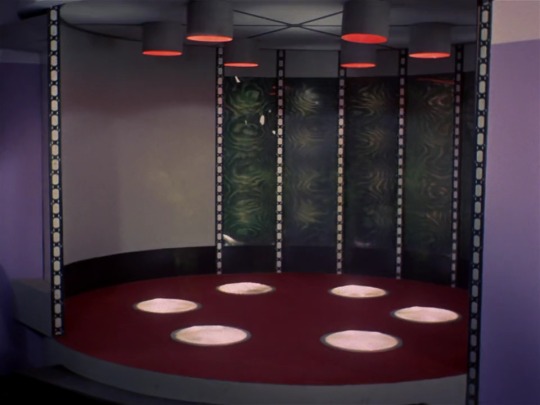
As I recall, the bottom disks had been either been salvaged or kept in storage and incorporated in the design of TNG’s transporters, flipped upside down so they were now at the top. The bottom had a glossy lightable circle with a smaller blue circle. The alcove panels were also meant to echo the frosted glass TOS transporter and they always looked a lil cloudy. As seen in Encounter at Farpoint:
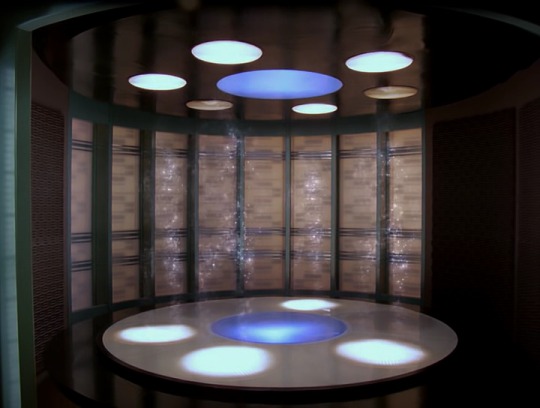
Problem was, no one knew where to stand on the pad when the cameras were rolling! So after keeping the clean configuration for the entire first season, the first redesign came in season 2:
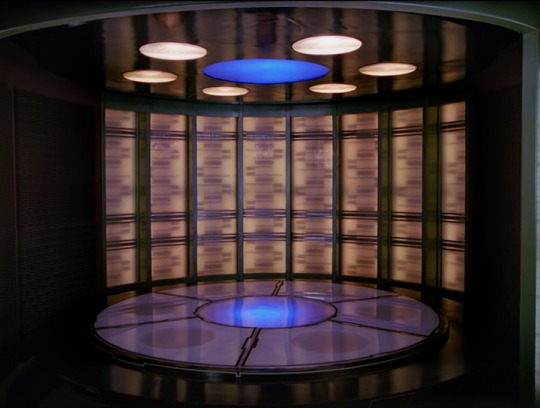
Now we have basic lines delineating each individual pad. it’s not bad but it’s still missing something. It will remain that way throughout the 2nd and 3rd seasons as well as Star Trek V (we’ll get back to that).
The next major redesign came during the 4th season episode Remember Me:
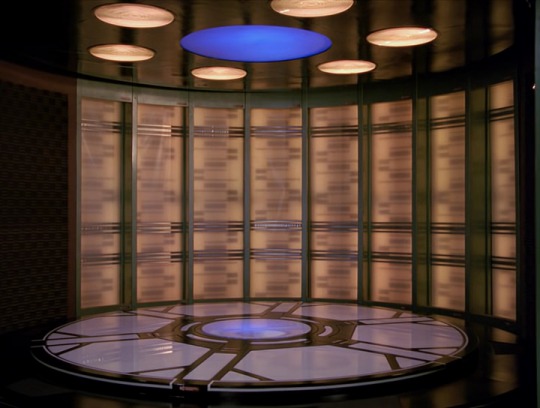
Now people are sure to know where to stand! Each individual pad space has been shrunk, including the central blue one, while also making it pop more visually. When in doubt, add lines (The interior design of the runabout would also follow that rule). This configuration would stay on for the remainder of the 4th and 5th season (and Star Trek VI, we’ll get back to that too). until one more change would be brought for the season 6 premiere:
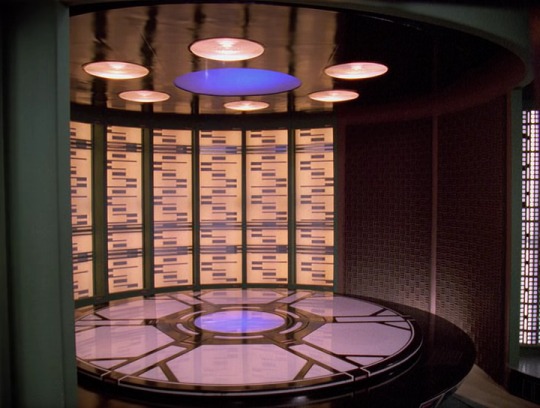
Speaking of making things pop, the backlit wall panels have been replaced.Gone is the frosted glass aspect, now the lines are cleaner. However, a small accident during Star Trek Generations’ production would damage those same panels, and a replacement was needed.
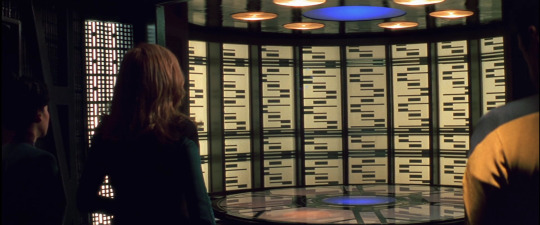
Nearly identical, but lit differently. And only there for about 7 seconds on screen. The TNG transporter room doesn’t stop there. The top and bottom elements would be recycled for Voyager’s otherwise brand new transporter rooms:

Voyager’s transporters would remain unchanged for the entire 7 year run. the top roundels that started in the 1960s would last until Voyager end in 2001.
Finally, the TNG transporter room sets also saw some use for the last two original series films. For Star Trek V:
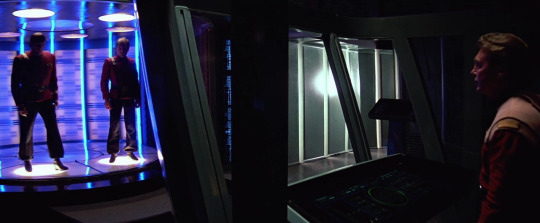
Filmed during TNG’s second season, includes a barely seen transporter control blast shield and some blue neon strips in the transporter bay. The isolinear stack that’s usually off to the side has also been removed.
Star Trek VI would dispense with the blue neon strips:
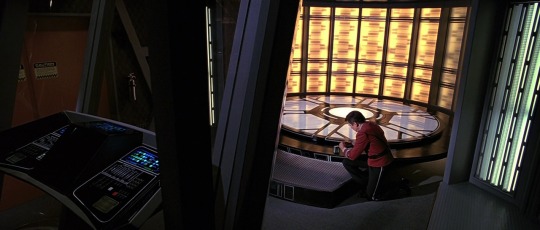
Filmed between TNG’s 4th and 5th season, The transporter room is again a re-use of the TNG set. The blast shielded transporter controls are trotted back out, signage on the door is changed and, because it’s Nick Meyer, a fire extinguisher next to the door. The lighting elements to the right and left of the pad have also been swapped.

- ')[1].split(' ')[0]; if(window.tumblrNotesLoaded)if(tumblrNotesLoaded(notes_html)==false)return;var more_notes_link=document.getElementById('more_notes_188777941000');var notes=more_notes_link.parentNode;notes.removeChild(more_notes_link);notes.innerHTML+=notes_html;if(window.tumblrNotesInserted)tumblrNotesInserted(notes_html);}};tumblrReq.open('GET','/notes/188777941000/5Yc9YVrKm?from_c=1636400897&large=true',true);tumblrReq.send();return false;">Show more notes Loading...
Memory Beta, non-canon Star Trek Wiki
A friendly reminder regarding spoilers ! At present the expanded Trek universe is in a period of major upheaval with the continuations of Discovery and Prodigy , the advent of new eras in gaming with the Star Trek Adventures RPG , Star Trek: Infinite and Star Trek Online , as well as other post-57th Anniversary publications such as the ongoing IDW Star Trek comic and spin-off Star Trek: Defiant . Therefore, please be courteous to other users who may not be aware of current developments by using the {{ spoiler }}, {{ spoilers }} OR {{ majorspoiler }} tags when adding new information from sources less than six months old (even if it is minor info). Also, please do not include details in the summary bar when editing pages and do not anticipate making additions relating to sources not yet in release. THANK YOU
Delta class transporter pad
The Delta class transporter pad was an essential requirement in growing colonies of the Romulan Star Empire .
History and specifications [ ]
These Romulan structures provide the vital link between the colony itself and the rest of the Star Empire.
Using its transporter capabilities, cargo can be imported or exported while further colonists can be beamed down to help crew the growing facilities of the colony. ( ST video game : New Worlds )
Appendices [ ]
References [ ].
- ST video game : New Worlds
Free Shipping to the 48 states!

- Buy with Prime
- Star Trek ComBadges
- Bluetooth Speakers
- Qi Wireless Chargers
- Power Banks
- All ComBadges
- Arizona State
- Florida State
- Find a Retailer
- Bluetooth ComBadge FAQ's
- Borg Cube FAQ's
- Enterprise 1701-D Speaker FAQ's
- Qi Charger FAQ
- User Guides
- Buy with Prime FAQ
- Firmware Update Instructions
- All Products
- Enterprise 1701-D Speaker
- All Star Trek
- All Doctor Who
- USER GUIDES
- FIND A RETIALER
- FIRMWARE UPGRADES
Featured Products
Please select a collection in Theme Setting to display the products (Sidebar -> Featured Products Sidebar)

Star Trek Qi Wireless Charger With Illuminated Transporter Pad & Built-In Power bank

This product qualifies for DISCOUNT.
Share for your chance to win great Fametek gear that we select at random!
You always need more power! Stay charged with your own Star Trek Qi Wireless charging pad with Built-In Battery & Illuminated Logo!
Unclutter your space and simplify charging with the Star Trek Wireless Charging Pad. FameTek’s design for an efficient and high-speed charging at 2.4A or 3A for Wired Connections or 10W for Wireless Charging that work for various tablets and phones like most Androids and iPhone’s 8 and up!
Just press the button to illuminate, lay your phone onto the charging pad and Go! There's no need to remove your iPhone from its case when powering up. The Star Trek Wireless Charging Pad can charge through most plastic cases.
With a Built-In Power bank you can charge your phone with a wired connection or wirelessly making this device 100% portable!
The illuminated TOS Transporter Pad lights up with backlit LED's when charging or when you press the check battery button which also lets you know when your device is being energized! Turn off the LED while charging, if desired, by pressing the side button once.
• Licensed Functional Collectible • Qi Wireless Charging 10w • Built-In Power Bank lets you Charge On-The-Go • 2.4 and 3A Fast Charging via USB-A or Type-C • Turn On or Off the LED Logo while Charging • Illuminated TOS Transporter Pad • Charge Wirelessly and W ired up to 3 Devices at the Same Time • Works for iPhone 8 & up, Samsung and other phones that support Qi • Charges Through Most Lightweight Cases
Specifications:.
Shipping & Returns
Shipping policy.
fametek.com offers free ground shipping within the 48 contiguous states. We do not support shipping outside of the U.S.
Returns Policy
When you receive your order, please inspect all packages for items such as remotes, manuals and cables, or any applicable accessories for the product(s) ordered. If the merchandise is not being installed right away, please power up or play the merchandise. Please be sure to save the box, and the shipping carton and its packing material, in the unlikely event that you'll need it for a return shipment. If you require any assistance, please send an e-mail and provide the order confirmation number with a brief explanation of your issue. Returns & Exchange Policies A return authorization is required for any exchange or refund. Any product shipped to us without a return authorization will be returned to the customer at his or her expense. We will issue a refund or exchange as long as the request is made within 30 days of the shipping date, the merchandise is returned in the same condition as it was when shipped, and is received in the original packing material and with all of its accessories such as: remote control, cables, antennas, connectors, brackets and owner's manuals. The merchandise returned will be inspected when it arrives at the warehouse and you will be charged for anything missing.
Related Products

$ 89.98 $ 64.98
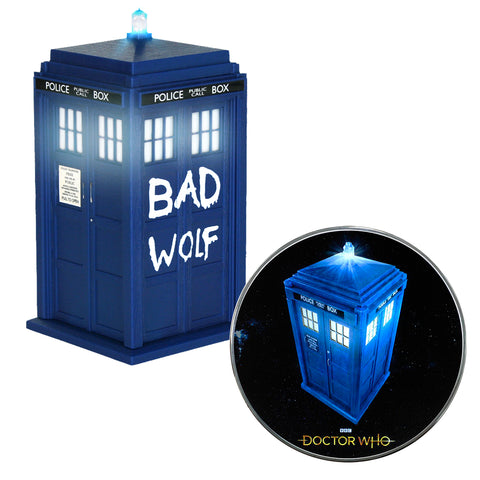
$ 89.98 $ 69.98
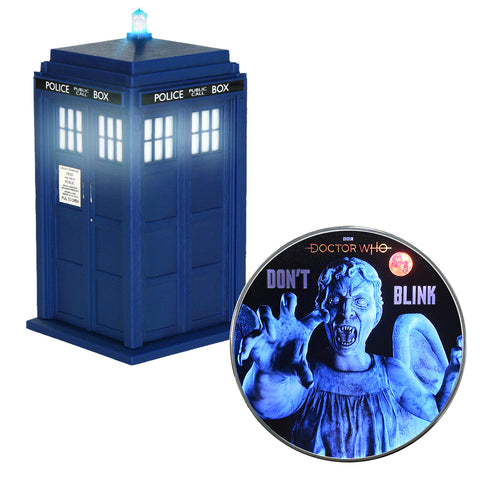
$ 89.98 $ 67.98
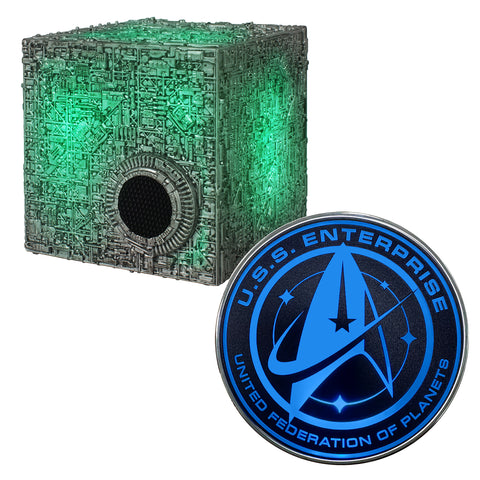
$ 114.98 $ 89.98
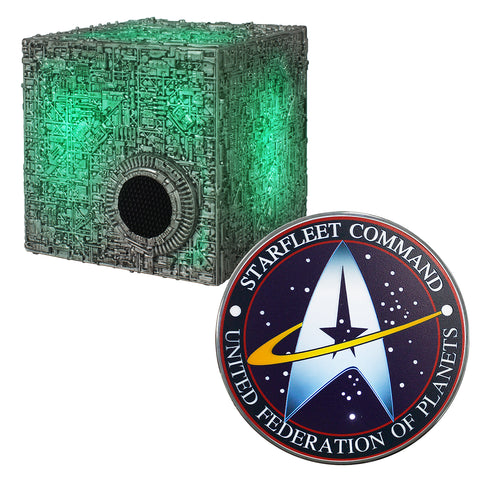
Recently Viewed Products
is added to your shopping cart.
is added to your wish list.
Availability
Product Type

- Search forums
Follow along with the video below to see how to install our site as a web app on your home screen.
Note: This feature may not be available in some browsers.
- Star Trek Movies
- Star Trek Movies: Kelvin Universe
The Tranpsorter Pad
- Thread starter Crewman47
- Start date Nov 18, 2009
- Nov 18, 2009
Not sure if it's been mentioned, but what do you suppose is the reasoning behind the pads on the Transporter? I mean there raised domes which means that your feet are slanted when you get on them. It must also be considered a hazard if you don't expect it and you slip cause you've just up from a slimy or muddy planet. What was wrong with just having a flat surface?
Vice Admiral
Do they stand on the domes? I don't remember that.
Jeri said: Do they stand on the domes? I don't remember that. Click to expand...
Yeah, ostensibly that lower center of gravity is supposed to help his stability. If I were standing there, I'd probably put my feet on the edges of it. I wonder if you have to be in contact with it.
Ok, ok. I just got back from Target with the ordinary vanilla DVD so I can make screen caps. In the meantime, here's one of Spock. The pads are pretty flat; they don't look hard to stand on. http://screenmusings.org/StarTrek/pages/Star-Trek-0976.htm Here's the Vulcans on the pads: http://screenmusings.org/StarTrek/pages/Star-Trek-1017.htm It doesn't look hard to balance on them.
KirkusOveractus
But it looked like Amanda had a hard time balancing on one...
^ Is that a joke? She had a hard time balancing on thin air.
Yeoman Randi
Crewman47 said: Not sure if it's been mentioned, but what do you suppose is the reasoning behind the pads on the Transporter? I mean there raised domes which means that your feet are slanted when you get on them. It must also be considered a hazard if you don't expect it and you slip cause you've just up from a slimy or muddy planet. What was wrong with just having a flat surface? Click to expand...
- Nov 19, 2009
Jeri said: ^ Is that a joke? She had a hard time balancing on thin air. Click to expand...
The King of Kings
Sabataage said: I remember that Spock is on the down while he's in the "crouching tiger" position just before beaming down to Vulcan. . Click to expand...
Nowhere Man
It looks to me like they are just raised up a little like standing on a giant beer bottle cap. I think the bubble in the middle is the only rounded thing there.
Johnnymuffintop
- Nov 20, 2009
They were probably made that way so you know whether or not you're standing on it. That way you wouldn't have to constantly be checking your footing.
^ Now, that is an excellent idea. In one of the novels, the author said Uhura installed toggles on her board so she'd hear the click.
Sign up / Register
- General Trek Discussion
- Star Trek: Enterprise
- Star Trek - The Original & Animated Series
- Star Trek: The Next Generation
- Star Trek: Deep Space Nine
- Star Trek: Voyager
- Star Trek: Discovery
- Star Trek: Picard
- Star Trek: Strange New Worlds
- Star Trek: Lower Decks
- Star Trek: Prodigy
- Star Trek Movies I-X
- Future of Trek
- Trek Gaming
- Trek Literature
- Fan Fiction
- Fan Productions
- CSI (at Talk CSI)
- Science and Technology
- Sports and Fitness
- Web Sites/Design
- Miscellaneous
- Site Forums
- More to Explore
- Series & Movies
Published Dec 8, 2015
Transporter Pad Coasters Ready to Beam Up

ThinkGeek has just introduced another winner to its line of exclusive Star Trek -themed products... Star Trek Transporter Pad LED Coasters. Available now in sets of four, the coasters resemble transporter pads from Star Trek: The Original Series .
Touch-sensitive, they light up for 10 seconds at a time and, when you put down or pick up a drink, they play the familiar materialization/dematerialization sound.
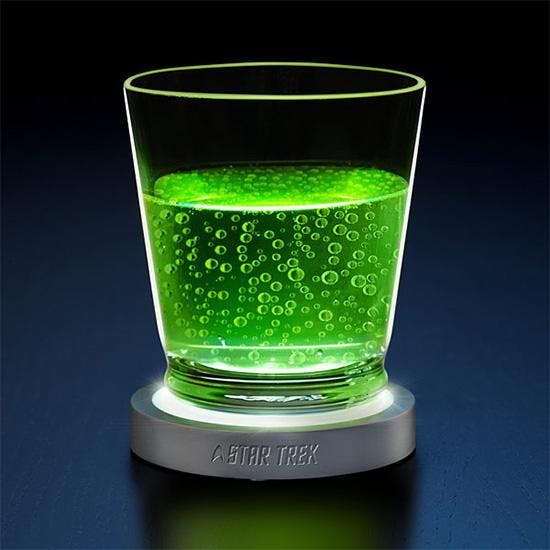
Each coaster is 3.5" in diameter and .5 inches thick. Batteries are not included. A set of four costs $29.99. Go to www.thinkgeek.com to purchase.
Get Updates By Email
Screen Rant
Strange new worlds does 3 important things that bring back classic star trek.

Your changes have been saved
Email Is sent
Please verify your email address.
You’ve reached your account maximum for followed topics.
Star Trek: Strange New Worlds Season 3 Will Be “Our Best Season So Far”, Says Anson Mount
Uhura & kirk's strange new worlds episode was “harder” than star trek’s musical for celia rose gooding, strange new worlds’ crossover started a great real life star trek friendship.
- Star Trek: Strange New Worlds combines classic and modern elements with nostalgic details from the Original Series.
- The show honors the franchise's past with updated designs and a modern touch.
- Physical sets and makeup effects enhance the show's realism and personality, setting it apart in the Star Trek universe.
Star Trek: Strange New Worlds is no stranger to using nostalgic details to boost its ongoing connection to Star Trek: The Original Series , and it does three important things to bring a classic Star Trek feel to an otherwise very modern production . In its first two seasons, Strange New Worlds ' characters , tropes, and creatures have introduced - and sometimes reimagined - essential aspects of Star Trek lore. The effortless blending of old and new makes the show an exciting prequel to Star Trek: The Original Series while encouraging a freshly modern take on the classic, established canon of past Star Trek projects.
The timeline of Star Trek TV shows and movies has been evolving for decades, and Strange New Worlds hasn't missed its opportunity to recognize the bygone eras of Star Trek . Strange New Worlds season 3 promises to bring even more new takes on quintessential characters, adding to the ranks of current regulars Lt. James T. Kirk (Paul Wesley), Captain Christopher Pike (Anson Mount), Ensign Nyota Uhura (Celia Rose Gooding), and Nurse Christine Chapel (Jess Bush) to further its association with TOS . However, instead of relying only on characters to connect to the past, Star Trek: Strange New Worlds utilizes three authentically Star Trek tactics.
Anson Mount hypes Star Trek: Strange New Worlds season 3, which he hints will take even bigger swings than the ambitious season 2 did.
Strange New Worlds' Sets Make The Show Feel Like Classic Star Trek
Detailed sets help strange new worlds seem more realistic.
The newest version of the USS Enterprise proves Star Trek: Strange New Worlds ' commitment to its 20th-century roots through meticulous set design. Second only to its iconic characters, the settings of Star Trek have always been near and dear to the heart of the franchise. Some of the most memorable moments from the best Star Trek movies and TV shows have happened on one of the franchise's many starships, and these sets often make returning to these projects feel like coming home . The sets of Star Trek: Strange New Worlds show off a vintage mid-century style with a sleek, futuristic edge.
Strange New Worlds utilizes many physical callbacks to Star Trek: The Original Series , like featuring the classic console design and the familiar circular pads of the transporter room. Captain Pike's living and working quarters provide 1960s stylistic choices and personal touches like horse figurines and Earth artifacts, making the space feel more lived-in. While every version of the Starship Enterprise has its own unique style that demonstrates different time periods, Strange New Worlds ' flagship recreates sets incorporate the classic Original Series bridge and uses Star Trek: The Next Generation 's style of warp core, calling back to TNG 's episodic environment.
Instead of using a green screen to depict a computer-generated backdrop, Star Trek: Strange New Worlds opts for physical settings with personal touches.
By rethinking familiar sets from previous Star Trek shows, Strange New Worlds creates space to introduce new designs that could become as iconic as the scenery that inspired them. Instead of using a green screen to depict a computer-generated backdrop, Star Trek: Strange New Worlds opts for physical settings with personal touches . Remaining loyal to the franchise's past lets the show honor classic characters, but adding a modern edge adds anticipation for new characters in future seasons and other upcoming Star Trek projects . Sets in Strange New Worlds are closely tied to characters, and character design adds to the setting.
Star Trek: Strange New Worlds' Makeup Gives Aliens More Character
Physical makeup effects instead of cgi help non-human characters feel personable.
Like its rejection of green screen backdrops, Star Trek: Strange New Worlds avoids computer-generated design for its alien characters. While Strange New Worlds ' first 2 seasons feature fewer recurring non-human characters than other Star Trek shows, its alien species have more personality thanks to their special effects makeup . Characters like Vulcan Lt. Spock (Ethan Peck) and Chief Engineer Lt. Hemmer (Bruce Horak) have prosthetics in every scene, and this choice makes them more personable than post-production CGI. The old-fashioned makeup choices are evidence of the show's desire to remain realistic while still honoring Star Trek 's sci-fi origin.
While a few characters wear minimal prosthetic makeup throughout the show, guest stars offer Star Trek: Strange New Worlds its biggest dose of classic one-off Star Trek aliens. One-episode characters such as Orion pirate Remy (Michael Hough) and the puppeteered Buckley are the greatest testament to the special effects makeup team on Strange New Worlds . The Orions' green skin is a simple but eye-catching design, but Klingons are a species whose iconic look is harder to nail. After divided opinions regarding Star Trek: Discovery 's controversial Klingons , the makeup for Klingon Ambassador Dak'Rah (Robert Wisdom) was among Strange New Worlds ' best accomplishments.
Strange New Worlds Made Star Trek's Gorn Scarier By Making Them Real
The gorn look and feel much scarier because they're hand-built animatronics.
The history of the Gorn in Star Trek canon is long and well-known, but Star Trek: Strange New Worlds changed the Gorn in a big way . The Original Series is often mentioned and reimagined in newer Star Trek shows, but Strange New Worlds ' Gorn take updating the past to a whole new level by retconning the stiff, humanoid costumes of the 1960s. Instead, the new Gorn are a terrifyingly deadly new alien species threatening Starfleet, but they still have a hint of Star Trek: The Original Series ' lizard-like enemies, with greenish skin and wide, hungry eyes.
Strange New Worlds changed the Gorn a lot from their original introduction in 1967, but updating them was essential for making them scarier and more fitting for a modern production. To achieve this updated look, creatives behind the scenes chose a more traditional route when redesigning the Gorn. From fully grown, aggressive adults to the smallest of hatchlings, the Gorn in Strange New Worlds are predominantly physical creatures in real life . Unlike a computer-generated species, these puppets and animatronics were explicitly created to show up more realistically on screen.
As seen in Paramount+'s The Ready Room on YouTube, Star Trek: Strange New Worlds ' Gorn are physical props on the set of the show. This change from CGI creatures featured in other Star Trek projects makes the Gorn scarier on screen , and actors also have the benefit of working face-to-face with their characters' terrifying adversary. Instead of acting against an unseen entity in front of a green screen, the cast of Strange New Worlds is subjected to real, physical creatures handled by crew members, moving and reacting in front of them in each scene.
Star Trek: Strange New Worlds is a modern production with a vintage twist , incorporating both old and new techniques and technology to blend classic and contemporary aspects of Star Trek . Its set designs offer the show a classic feel, calling back to Star Trek: The Original Series and shows from the 90s era of Star Trek . The characters make the meticulously detailed sets come to life with more personable character design, thanks to old-fashioned makeup and traditional prosthetics. The newly designed Gorn offer Star Trek: Strange New Worlds the perfect adversary for a show determined to be both old and new.
Star Trek: Strange New Worlds
A spin-off of Star Trek: Discovery, Star Trek: Strange New Worlds is a television series that takes place before the events of the original series and follows Captain Christopher Pike as he mans the helm of the U.S.S. Enterprise. The show focuses on this previous crew of the Enterprise as they explore the galaxy with returning characters from Discovery.
Star Trek: The Original Series
*Availability in US
Not available
Star Trek: The Original Series follows the exploits of the crew of the USS Enterprise. On a five-year mission to explore uncharted space, Captain James T. Kirk (William Shatner) must trust his crew - Spock (Leonard Nimoy), Dr. Leonard "Bones" McCoy (Forest DeKelley), Montgomery "Scotty" Scott (James Doohan), Uhura (Nichelle Nichols), Chekov (Walter Koenig) and Sulu (George Takei) - with his life. Facing previously undiscovered life forms and civilizations and representing humanity among the stars on behalf of Starfleet and the United Federation of Planets, the Enterprise regularly comes up against impossible odds and diplomatic dilemmas.

- Cell Phones & Accessories
- Accessories
- Chargers & Power Adapters
- Wireless Chargers

Enjoy fast, free delivery, exclusive deals, and award-winning movies & TV shows with Prime Try Prime and start saving today with fast, free delivery
Amazon Prime includes:
Fast, FREE Delivery is available to Prime members. To join, select "Try Amazon Prime and start saving today with Fast, FREE Delivery" below the Add to Cart button.
- Cardmembers earn 5% Back at Amazon.com with a Prime Credit Card.
- Unlimited Free Two-Day Delivery
- Streaming of thousands of movies and TV shows with limited ads on Prime Video.
- A Kindle book to borrow for free each month - with no due dates
- Listen to over 2 million songs and hundreds of playlists
- Unlimited photo storage with anywhere access
Important: Your credit card will NOT be charged when you start your free trial or if you cancel during the trial period. If you're happy with Amazon Prime, do nothing. At the end of the free trial, your membership will automatically upgrade to a monthly membership.
Return this item for free
We offer easy, convenient returns with at least one free return option: no shipping charges. All returns must comply with our returns policy.
- Go to your orders and start the return
- Select your preferred free shipping option
- Drop off and leave!
Return instructions

Image Unavailable

- To view this video download Flash Player
Star Trek Wireless Charger with Built-in Backup Battery Pack for Wired and Wireless Charging. Portable Wireless Phone Charger with Transporter Pad Illuminated Logo. StarTrek Gifts, Collectibles

Purchase options and add-ons
About this item.
- GREAT GIFT FOR STAR TREK FANS | This Star Trek Wireless Charger is much more than just a convenient way to charge your phone or tablet. With an Illuminated Starfleet logo that looks beautiful when the device is charging this wireless charger is a great gift for Sci-Fi fans looking for a unique Star Trek collectible. You can even Turn OFF the top LED by holding down the power button while charging! Press once to turn back on and double press to power down!
- THE GIFT THAT KEEPS ON GIVING | The Star Trek Wireless Charger with Backup Battery Pack and Illuminated Emblem allows you to charge your phone wirelessly at 10W, 2/A . You can also charge your phone or tablet via USB-A or Type-C at 3A for faster charging while on the go! It’s built-in Backup Battery allows for true portability, meaning you can charge wirelessly (or wired) without being plugged into a power source. The rechargeable Lithium-ion Battery is recharged via the supplied Micro USB
- PHONE AND ANDROID COMPATIBLE | Don’t worry anymore when you misplace your charging cable! With technology you are able to wirelessly charge any phone or tablet that has that wireless charging capability as well as iPhones 15 and up! Charge any device via your USB cable at the same time as your wireless charge!
- EXTRA FEATURES | Charge 3 devices at once! Charge one device wirelessly and the other devices via USB-A and Type-C. The Illuminated Emblem lights up with a backlit LED when charging or when you press the check battery button to let you know when your device is being energized! Turn off the LED while charging, if desired, by holding down the side button until the LED is OFF.
- Compatible with iPhone 15, iPhone 14, iPhone 13, iPhone 11 Pro & Max, iPhone 12 Pro & Max, iPhone X, iPhone XS, iPhone XS Max ,iPhone XR ,iPhone 8 Plus, iPhone 8, S23, S22, S20,S10, S9, S9 Plus, Note 20, Note 10, Note 9, Note 8, Galaxy S8, S8 Plus, Razer RAZER Phone 2 Galaxy S10 / S9 / S9 plus / S8 / S8 plus / S7 / S7 edge / S6 edge plus / Note9 / 8 / 5 ; 7.5W FAST charge is compatible with iPhone Xs / iPhoneXR / iPhoneXS Max / iPhoneX / iPhone8 / iPhone8 Plus
Consider a similar item

Buy it with

Videos for similar products

What's in the box
- USB-A cable, Type-C cable, Micro USB cable, Illuminated Starfleet logo
Compare with similar items
Videos for this product.

Click to play video

Star Trek Beam Me Up! Wireless Charger with Backup Battery

Star Trek Wireless Charger for Samsung & iPhone
RVR2-Reviews

Star Trek Qi Wireless Charger

Star Trek Triple Charging Qi Chargers
Product description.

FAMETEK allows you to experience high quality sound, functionality and fabrication as a fan or collector! We excel not only in sound quality but also in high and fabrication and our dedication to authentic replicas shows up on every piece we design. We only create products we are passionate about! Not only are you benefiting from over 30 years of combined experience in engineering, manufacturing, and just plain excitement for collecting.
STAR TREK QI WIRELESS CHARGER
Unclutter your space and simplify charging with this Startrek Wireless Charging Pad. 3A for wired connections or standard 1A for wireless that work for tablets and phones, Androids and iPhones 8 and Up! Just press the button to illuminate and charge! No need to remove your phone from most cases when powering up. The Built-In Power Bank makes this device 100% portable! The Illuminated logo lights up beautifully when charging. Turn off the LED while charging if desired by pressing the side button!
- Licensed Functional Collectible
- Qi Wireless Charging
- Built-In Power Bank lets you Charge On-The-Go
- LED Illuminated Logo with ON/OFF button
- Works for iPhone 8 & up, Samsung and other phones that support Qi
- Charges Through Most Lightweight Cases
Product information
Warranty & support, looking for specific info, customer reviews.
Customer Reviews, including Product Star Ratings help customers to learn more about the product and decide whether it is the right product for them.
To calculate the overall star rating and percentage breakdown by star, we don’t use a simple average. Instead, our system considers things like how recent a review is and if the reviewer bought the item on Amazon. It also analyzed reviews to verify trustworthiness.
Customers say
Customers like the appearance of the charging adapter, saying it looks cool and is striking. However, some customers have mixed opinions on charging, performance, value, lighting, and quality.
AI-generated from the text of customer reviews
Customers are satisfied with the appearance of the charging adapter. They mention that it looks cool, unique, and striking. Some say that the lighting of the Star Trek emblem is striking.
"For it it looks cool so how well it works is probably secondary. I did drop it, and the top came off and I put it back together easily...." Read more
"...It looks really cool when lit up ...." Read more
"...It's also a great looking unit , an I love that the Starfleet Seal lights up when the unit is in operation...." Read more
"...Returned mine. Sadly the gift was not returned. It really is cool looking but too expensive to just sit around without a purpose." Read more
Customers like the charging adapter as a gift. They mention it's a solid gift option, and very futuristic.
"...My husband loves it! Great present !" Read more
"This was a really neat gift . Had excellent lighting until the charge port became loose and I was no longer able to use it...." Read more
"great product...very futuristic... good packaging .very happy with my purchase...this thing is super cool!" Read more
" Great gift for any Trek fan ..." Read more
Customers have mixed opinions about the charging adapter. Some find it wonderful and handy with the wireless charging function. However, other customers report issues with the charging. They say that the wireless charger turns off after a minute and that the adapter does not light up to charge.
"...It will not hold a charge on my phone and turns off randomly. It looks really cool when lit up...." Read more
"...Most important is that it looks really cool, it is a great federation light up charger . I love the LED backlight to really make the logo look great." Read more
" It doesn't hold a charge or give a decent one. Doesn't work, I assume. Or well, anyways." Read more
" Very cool device for charging your phone wirelessly , and via wired connection. Charges up fast as well as charges your devices rapidly too!..." Read more
Customers are mixed about the performance of the charging adapter. Some mention it works excellent, functional, and affordable. They are pleasantly surprised at the extra functions. Others however, say that it does not work well and did not work with any of their devices.
"...Probably similar to other wireless charging. It works. The battery feature works well , too, it holds charge OK when charged and then you can use it..." Read more
"...He loved it! But it didn't work well or all the time. So he returned it but wanted to see if another one would work...." Read more
"...So to say the least we were both pleasantly surprised at the extra functions ." Read more
"... Discovered neither of them ever worked . Returned mine. Sadly the gift was not returned...." Read more
Customers are mixed about the lighting of the charging adapter. Some mention that it lights up bright enough to see from orbit, the face lights up, and the LED backlight makes the logo look great. However, others say that it is very bright at night, doesn't work, and that the Starfleet Seal lights up when the unit is in operation.
"...I love the LED backlight to really make the logo look great." Read more
"...be taken with you as wireless portable charger, while the Star Wars charger has no lights , and you can’t charge two at the same time, or unplug it..." Read more
"...It's also a great looking unit, an I love that the Starfleet Seal lights up when the unit is in operation...." Read more
"...It’s fun, beautiful, and the lights are bright . You are capable of manually turning the light off if needed while it is charging...." Read more
Customers have mixed opinions about the value of the charging adapter. Some find it well worth the money, while others say it's overpriced and not functional.
"...That being said if you live in the Lower 48 this is well worth it ...." Read more
"...Sadly the gift was not returned. It really is cool looking but too expensive to just sit around without a purpose." Read more
"...For any Star Trek fans, I highly recommend this product. It’s fun , beautiful, and the lights are bright...." Read more
"...This is great and explains the price . I can take the puck with me, slap it down at work, charge my phone, then bring it back and start all over...." Read more
Customers have mixed opinions about the quality of the charging adapter. Some mention it's well made and reliable, while others say it'll break easily.
"It looks cool as can be. I feels substantial and I love that you can take it with to charge anywhere. But there is a finicky sweet spot to connect...." Read more
"...It is not like a Star Trek product to be so poorly made . It looks nice but does not do the job." Read more
" Well made and engineered with bonus features that would be expected from a product that was at twice the cost! Thank you! I am glad I bought two...." Read more
"Worked okay for awhile then the battery swelled and blew the whole thing apart . Probably lucky it didn’t burn my house down." Read more
Reviews with images

- Sort reviews by Top reviews Most recent Top reviews
Top reviews from the United States
There was a problem filtering reviews right now. please try again later..
Top reviews from other countries
- Amazon Newsletter
- About Amazon
- Accessibility
- Sustainability
- Press Center
- Investor Relations
- Amazon Devices
- Amazon Science
- Sell on Amazon
- Sell apps on Amazon
- Supply to Amazon
- Protect & Build Your Brand
- Become an Affiliate
- Become a Delivery Driver
- Start a Package Delivery Business
- Advertise Your Products
- Self-Publish with Us
- Become an Amazon Hub Partner
- › See More Ways to Make Money
- Amazon Visa
- Amazon Store Card
- Amazon Secured Card
- Amazon Business Card
- Shop with Points
- Credit Card Marketplace
- Reload Your Balance
- Amazon Currency Converter
- Your Account
- Your Orders
- Shipping Rates & Policies
- Amazon Prime
- Returns & Replacements
- Manage Your Content and Devices
- Recalls and Product Safety Alerts
- Conditions of Use
- Privacy Notice
- Consumer Health Data Privacy Disclosure
- Your Ads Privacy Choices

The Best Star Trek Transporter Mishap Episodes
J ust as Star Trek wouldn’t be the same without the technology Gene Roddenberry and subsequent creators imagined, it wouldn’t be the same without the stories about that fantastic tech going sideways. For example, there’s episodes about Star Trek’s transporters malfunctioning and transporting heroes to different times, transporting them to different universes, and sometimes creating brand new, bizarre life.
Here, for your consideration, are our choices for the best Star Trek transporter mishap episodes.
7. “Second Chances” Star Trek: The Next Generation
Eight years before the events of this Season 6 Star Trek: The Next Generation episode, Will Riker (Jonathan Frakes) steps onto a transporter pad, not knowing that getting beamed off the surface of Nervala IV would inadvertently create a duplicate of himself. The strange event forces Riker to confront his past in a very real way — specifically in terms of his willingness to abandon his earlier romance with Deanna Troi (Marina Sirtis) for the sake of his career.
Naming himself Thomas Riker, the transporter duplicate returned in a Season 3 episode of Star Trek: Deep Space Nine as an antagonist and member of the Maquis. The last we see of him, he’s made a prisoner by the Cardassians. His ultimate fate is never revealed, but the most likely outcome is that he was executed by the Dominion, along with the rest of the captured Maquis, when they took over Cardassia.
6. “Tuvix” Star Trek: Voyager
In what remains one of the most controversial Star Trek episodes among fans, a trip through the transporter merges the Vulcan security chief Tuvok (Tim Russ) with the Talaxian morale officer Neelix (Ethan Phillips) to make a brand new person — Tuvix (Tom Wright).
It takes the crew of Voyager a few weeks to figure out how to safely separate Tuvok and Neelix, by which point Tuvix has made friends, worked with the crew, and sees himself as an individual distinct from either the Vulcan or the Talaxian. To bring Tuvok and Neelix back, he argues, would mean murdering Tuvix. Fans still debate about whether or not, when Captain Janeway (Kate Mulgrew) brings Tuvok and Neelix back, it’s a surgery or an execution.
5. “Our Man Bashir” Star Trek: Deep Space Nine
Star Trek: Deep Space Nine had significantly fewer holodeck mishap episodes than its contemporaries TNG and Voyager , but in Season 4’s “Our Man Bashir,” it makes up for the absence by combining a holodeck mishap story with a transporter mishap story.
While Julian Bashir (Alexander Siddig) happens to be enjoying his James Bond fantasy program in the holosuite, a runabout explodes and the transporter patterns of the runabout’s crew are stored in the holosuite because it’s the only place on the station with the memory to bear it. Consequently, DS9 regulars like Kira (Nana Visitor), Worf (Michael Dorn) and even Ben Sisko ( Avery Brooks ) take on the roles of characters in Bashir’s program.
“Our Man Bashir” not only gives Star Trek fans a great transporter mishap episode, but a wonderful nod to the heyday of 007, not to mention an important step in the development of Bashir’s character.
4. “Past Tense” Star Trek: Deep Space Nine
The 21st century is a dark time in Star Trek lore, and a transporter mishap sends Ben Sisko, Julian Bashir, and Jadzia Dax ( Terry Farrell ) back to that difficult time in the two-parter “Past Tense.” The story finds Bashir and Sisko struggling among the most impoverished of San Francisco’s citizens, while Jadzia finds herself a guest of Chris Brynner (Jim Metzler), one of the city’s wealthiest men.
With the bleak looking 21st century looking much more like the real world than the utopia the heroes are trying to get back to, “Past Tense” is a cold splash of water for anyone hoping we’ll one day achieve what the fictional people of the Federation have.
3. “Relics” Star Trek: The Next Generation
We’re kind of cheating here because this classic Star Trek crossover doesn’t come about because of a transporter mishap so much as a transporter working better than anyone ever expected. When the Enterprise responds to a distress call from a ship that’s been missing for seventy five years, they run into Captain Montgomery Scott (James Doohan) who kept himself alive by keeping his pattern cycling in the transporter buffers (though sadly his colleague Matt Franklin is lost).
“Relics” is a fantastic episode of Star Trek. It not only gives us one of our few chances to see a character from the original series interact with the cast of The Next Generation , but it tells a moving story about the elderly being made to feel irrelevant.
2. “Drone” Star Trek: Voyager
In this later episode of Star Trek: Voyager , the transporter patterns of The Doctor (Robert Picardo) and Seven of Nine ( Jeri Ryan ) briefly merge, causing the 29th century technology of the Doctor’s holo-emitter to interact with Seven’s Borg nano-probes, ultimately creating a new Borg.
The new Borg — named One (J. Paul Boehmer) — unintentionally becomes a threat when the Collective learns about him and comes calling with the hopes of assimilating his vastly superior technology. One makes the choice that settles things himself, and his solution makes “Drone” one of the most heartbreaking episodes of the series.
1. “Mirror, Mirror” Star Trek: The Original Series
Of course, you had to know this was coming. It was the original Star Trek that was home to the most impactful transporter mishap tale — “Mirror, Mirror” which introduced us to the dark Mirror Universe. Because of an anomaly, Kirk ( William Shatner ) Scotty, Uhura (Nichelle Nichols), and McCoy (DeForest Kelley) find themselves in a parallel universe in which the benevolent United Federation of Planets is replaced with the brutal Terran Empire.
The Mirror Universe would prove popular enough that it was brought back for DS9 , Enterprise , and in particular was heavily mined in Star Trek: Discovery .
The post The Best Star Trek Transporter Mishap Episodes appeared first on GIANT FREAKIN ROBOT .
GIANT FREAKIN ROBOT
- Keanu Reeves' Forgotten Horror Movie Is Now Streaming On Max
- New Star Wars Series Canceled, Creators Fired
- Why Star Trek Is Suddenly Canceling Its Shows
Pulled Pork Leftovers From Your Cookout? Try These 13 Creative Recipes


COMMENTS
A 22nd century transporter platform. DSK-7 tranporter platform. The transporter pad in Ops on DS9 in use. The transporter platform or transporter pad was a raised area in the transporter room; it was located within the transporter chamber.The platform had transporter pads, where the individual or object that was being transported had to be placed in order to be successfully transported.
The truth behind transporter tech is far scarier. The device works by turning the person's mass into energy, quite literally beaming said energy to the intended destination, and then converting it ...
Of course for all things Star Trek Memory Alpha has the answers. Regarding transporter pads: The transporters installed on Earth's NX-class starships featured one large circular pad that took up the entire platform. It was large enough to transport two to three people, provided they stood close together.
Creating the original STAR TREK energize effect. Watch on. Shanks told Vice: "From my research it started with them using aluminum silver shavings, and just dropping it in front of the camera ...
Sci-fi. Star Trek. The transporter pad (or transporter platform) is a vital component of the transporter system, where in which an object or individual stands so that they can be transported to the desired location. Aboard Federation starships a standard transporter contains six transporter pads for personnel...
A transporter is a fictional teleportation machine used in the Star Trek universe.Transporters allow for teleportation by converting a person or object into an energy pattern (a process called "dematerialization"), then sending ("beaming") it to a target location or else returning it to the transporter, where it is reconverted into matter ("rematerialization").
In Star Trek: Voyager, another malfunction -- in concert with an alien flower -- bonded two characters together into a new being in the episode "Tuvix." As recently as 2023, the transporters were used in Star Trek: Picard as a key element of the Borg's plan to stealthily invade Starfleet by assimilating the officers under the age of 25. This ...
Basically, the transporter system is automatically aware of anything on the pad, because that area is equipped with the molecular-level scanners that are used for recording the subject's makeup for transport. For a one-way trip to the pad, the ship's sensors only need to reach out and "lock on" to the subject at their origin. Re-integration of ...
The transporter was a type of teleportation machine, or simply teleporter. It was a subspace device capable of almost instantaneously transporting an object from one location to another, by using matter-energy conversion to transform matter into energy, then beam it to or from a chamber, where it was reconverted back or materialize into its original pattern. (TOS: "The Squire of Gothos", "The ...
Star Trek has "broken" the rules of transporters a number of times. There are very few glaring examples of misuse of the transporter as a plot device to save the day, but the worst include: "Rascals" [TNG] - Picard, Keiko, Guinan and Ro are turned into children in a freak transporter accident, and later restored.
The Transporter Pads act like a giant, fixed version. Safer, more secure, less risk, etc. Also, security purposes; if ships are linking their transporter pads to transport, it means that you know where people are arriving, and you don't get intruders showing up willy-nilly.
I should imagine in a post-capitalism, post-scarcity society like that of Star Trek that Starfleet design and manufacture their own transporters. ... I assume the transporter pad is located pretty much directly above the transport and so is the closest somebody can be to the transporter. If one wants to save as much energy as possible for other ...
Like the Bridge, the Transporter Room in Star Trek: The Next Generation was always evolving. It started, in part, with the The Original Series' transporter room: ... Each individual pad space has been shrunk, including the central blue one, while also making it pop more visually. When in doubt, add lines (The interior design of the runabout ...
The Delta class transporter pad was an essential requirement in growing colonies of the Romulan Star Empire. These Romulan structures provide the vital link between the colony itself and the rest of the Star Empire. Using its transporter capabilities, cargo can be imported or exported while further colonists can be beamed down to help crew the growing facilities of the colony. (ST video game ...
Features: • Licensed Functional Collectible. • Qi Wireless Charging 10w. • Built-In Power Bank lets you Charge On-The-Go. • 2.4 and 3A Fast Charging via USB-A or Type-C. • Turn On or Off the LED Logo while Charging. • Illuminated TOS Transporter Pad. • Charge Wirelessly and W ired up to 3 Devices at the Same Time.
You can see the curve better on the pad behind Spock and to the right. I was wondering if the floor of the transporter use to be the ceiling of a previous transporter. I remember reading they had done that with a TOS transporter for a TNG transporter pad.
You can but you still need a transporter as in interim stop, even if you dont materialize on the pad. Think of the pad/transporter as the router in your beam transfer path. Transporter picks you up on the planet, stores you in the transporter, sends you to the bridge. Obviously there is lots of extra targeting and the like involved.
ThinkGeek has just introduced another winner to its line of exclusive Star Trek-themed products...Star Trek Transporter Pad LED Coasters. Available now in sets of four, the coasters resemble transporter pads from Star Trek: The Original Series.. Touch-sensitive, they light up for 10 seconds at a time and, when you put down or pick up a drink, they play the familiar materialization ...
The sets of Star Trek: Strange New Worlds show off a vintage mid-century style with a sleek, futuristic edge. Strange New Worlds utilizes many physical callbacks to Star Trek: The Original Series, like featuring the classic console design and the familiar circular pads of the transporter room. Captain Pike's living and working quarters provide ...
In Star Trek Online, which is set in the early 25th century, a character can pretty much beam anywhere (within transporter range) using a pad or not. But, again, that makes sense that, as time passes, transporting becomes safer, easier, and technologically simpler.
STAR TREK TRANSPORTER PAD: Input Voltage: 5 Volts (DC) Mounting Type: Tabletop Mount: Amperage: 5 Amps: See more. About this item . GREAT GIFT FOR STAR TREK FANS | This Star Trek Wireless Charger is much more than just a convenient way to charge your phone or tablet. With an Illuminated Starfleet logo that looks beautiful when the device is ...
The 21st century is a dark time in Star Trek lore, and a transporter mishap sends Ben Sisko, Julian Bashir, and Jadzia Dax (Terry Farrell) back to that difficult time in the two-parter "Past ...
A casual, constructive, and most importantly, welcoming place on the internet to talk about Star Trek Members Online ... I assume what's really happening is they're first beamed from the planet to the transporter pad, and then from the transporter pad to sickbay. This happens one immediately after the other, so from the point of view of the ...
When they built the TNG transporter set, they incorporated the lenses into the TNG ceiling. At the end of TNG the set was repurposed into the Voyager transporter room. After Voyager's run concluded the set was fully dismantled to make room for Star Trek: Enterprise sets. I don't believe the TOS transporter pad lenses have been reused again for ...